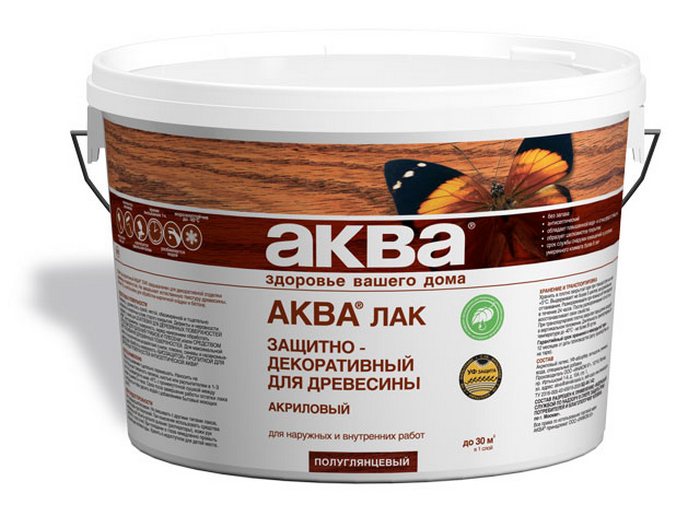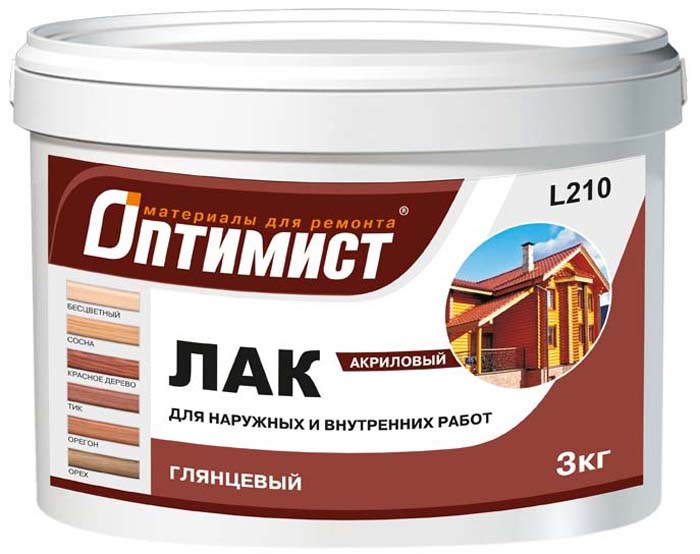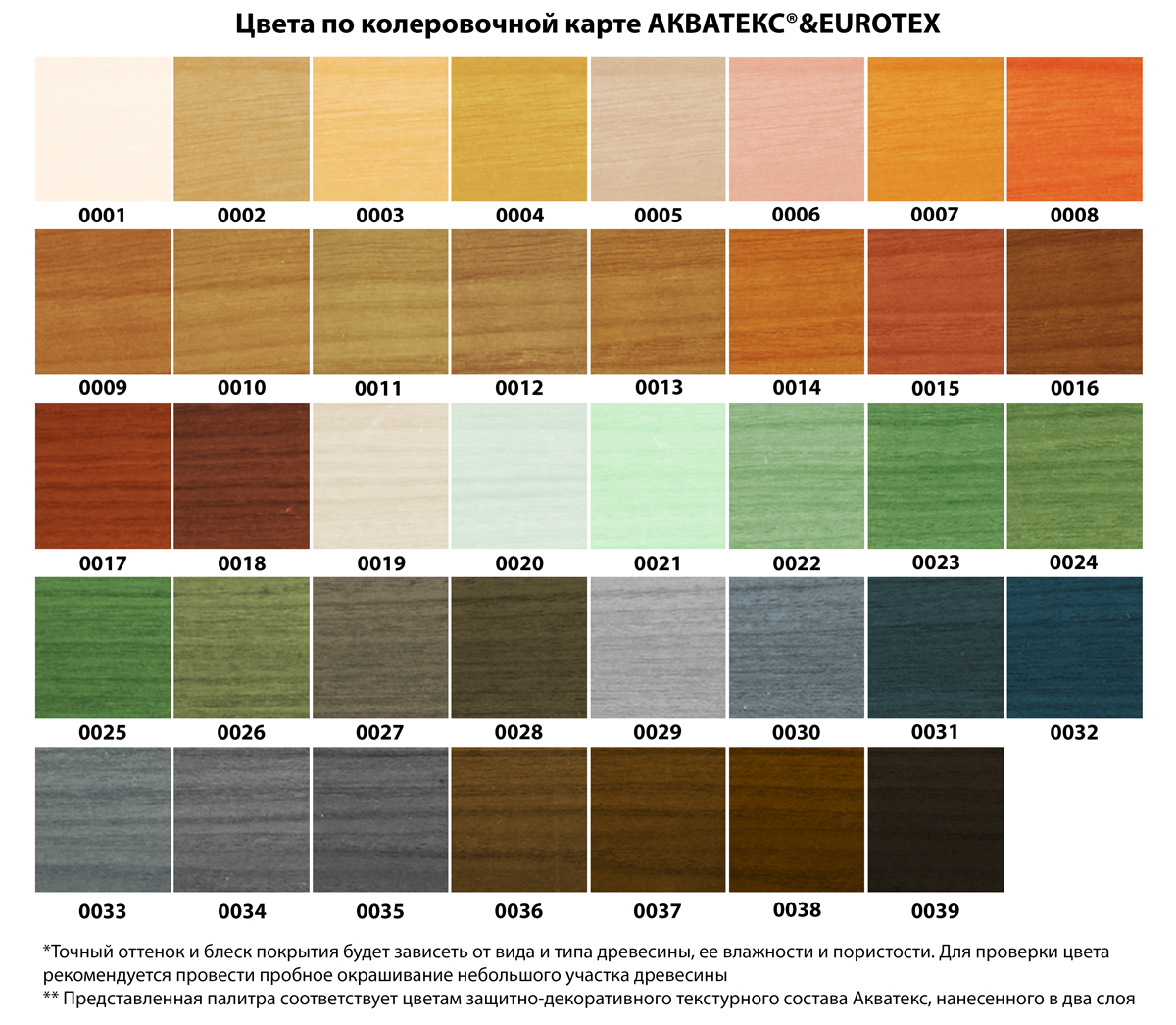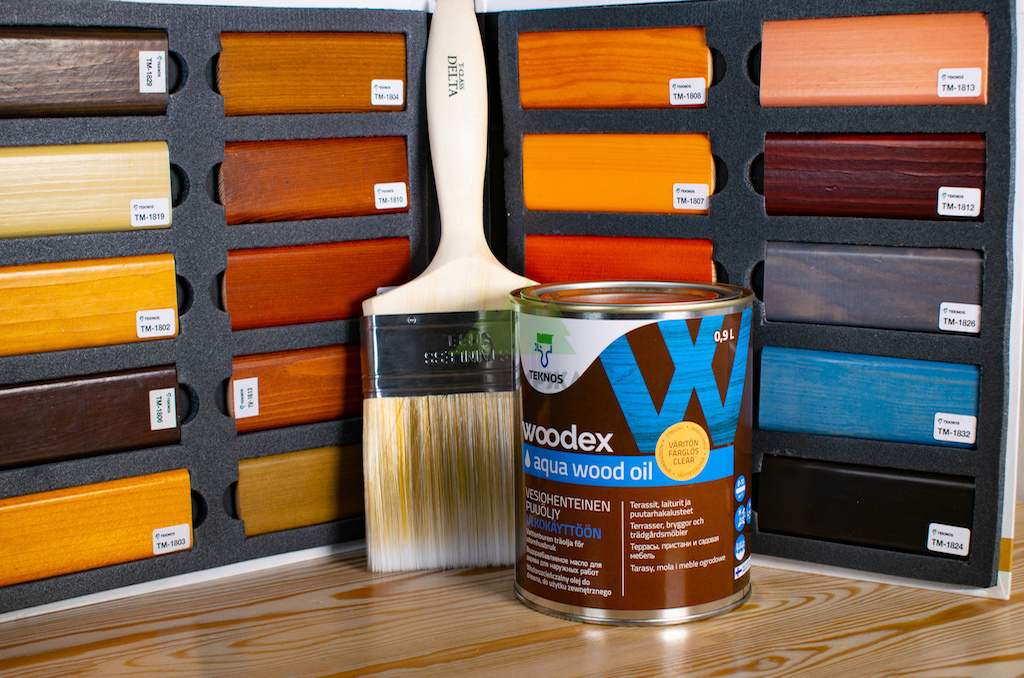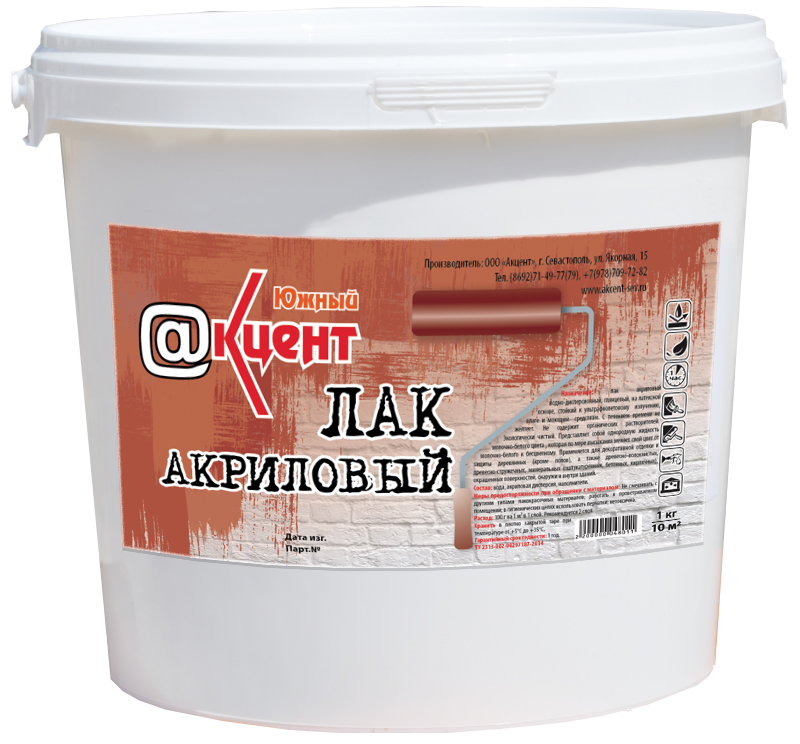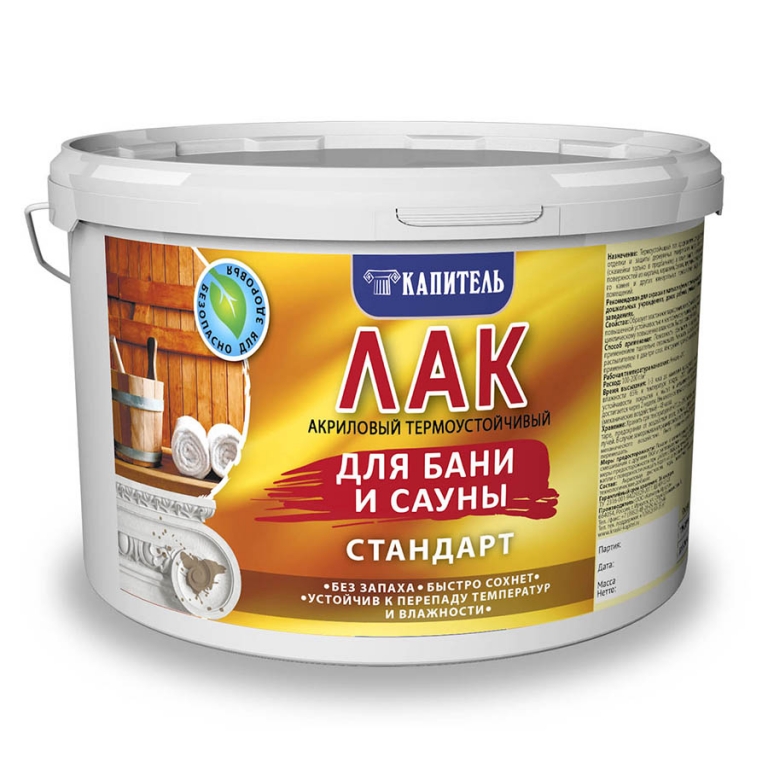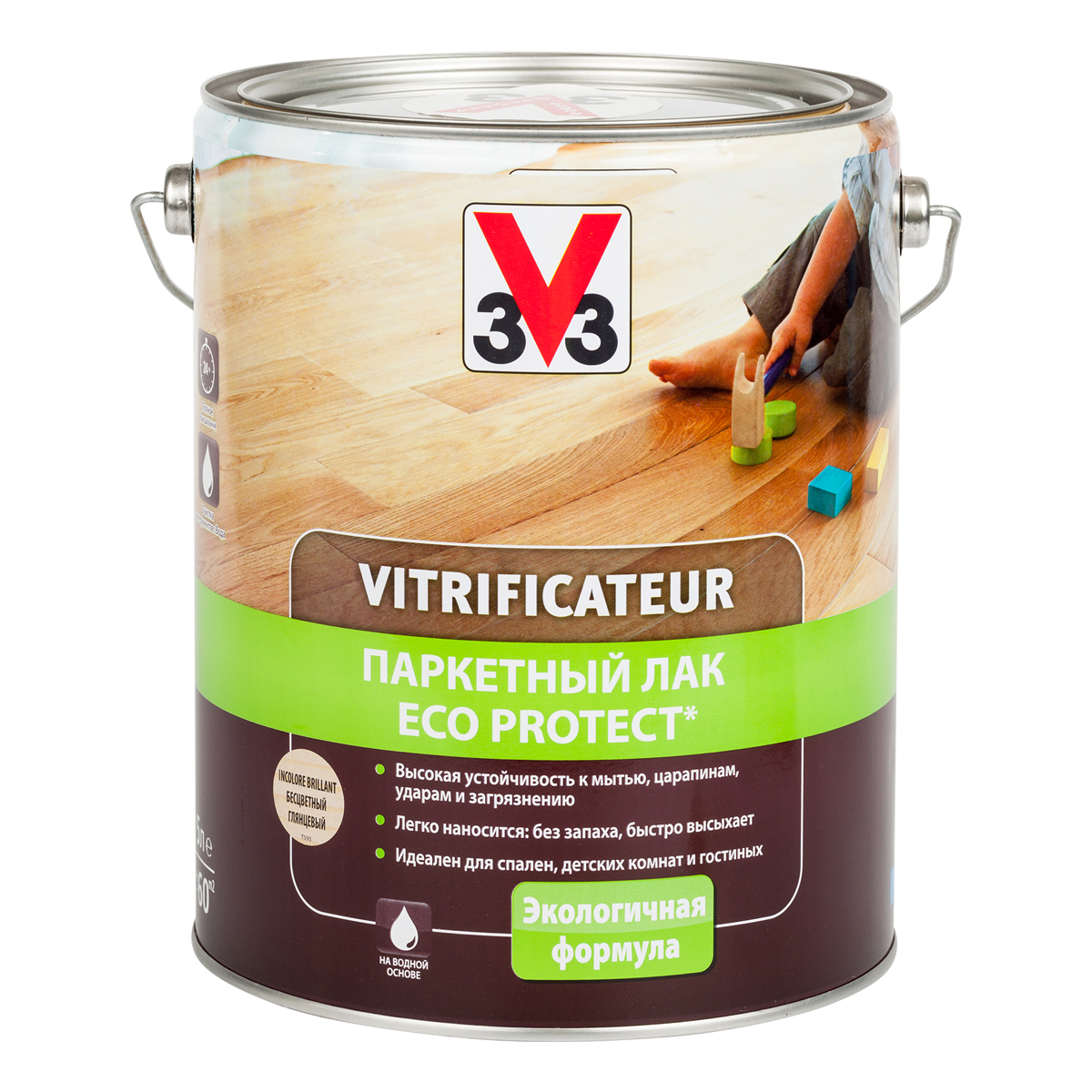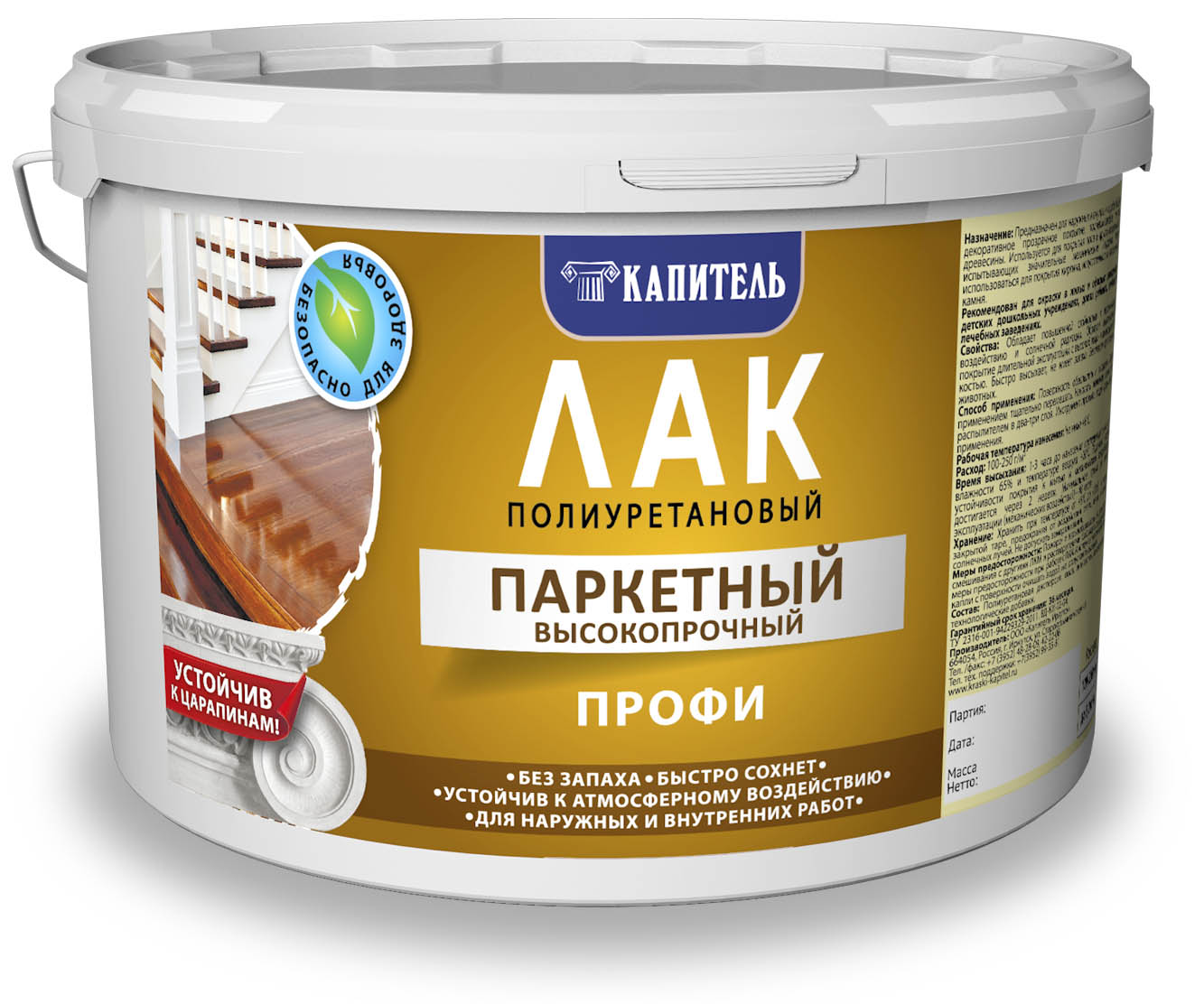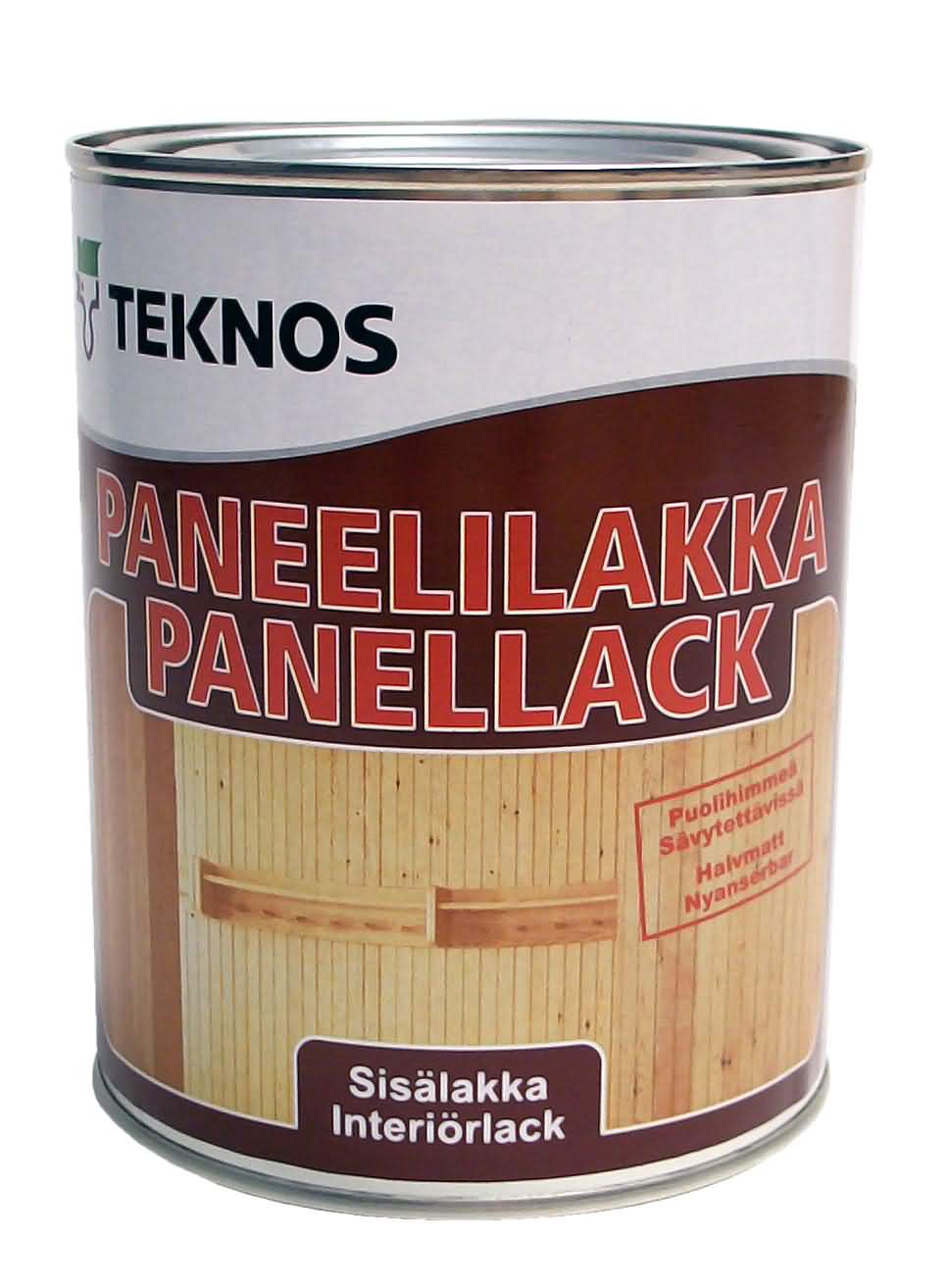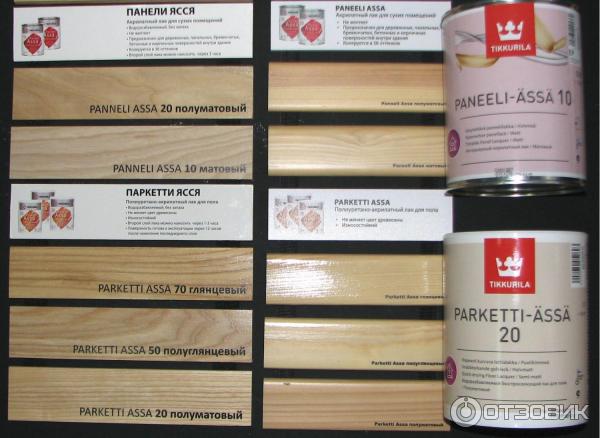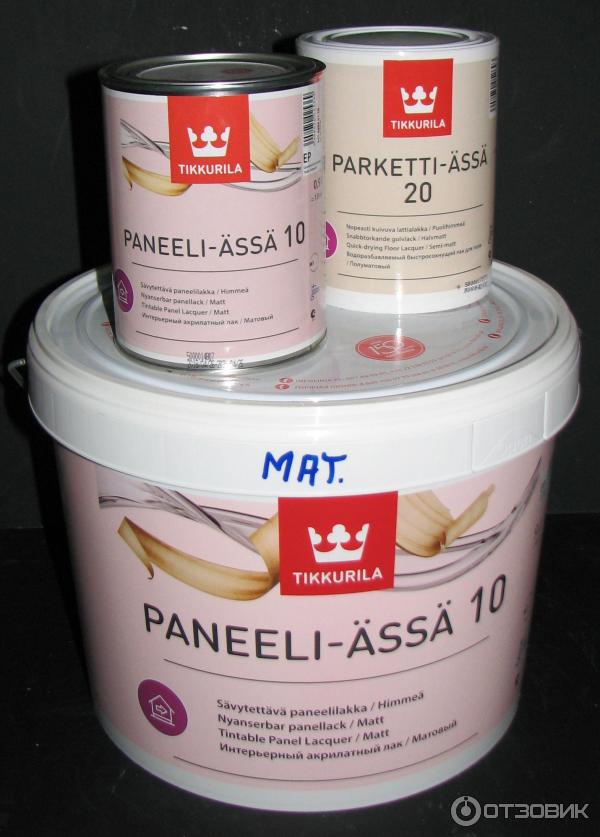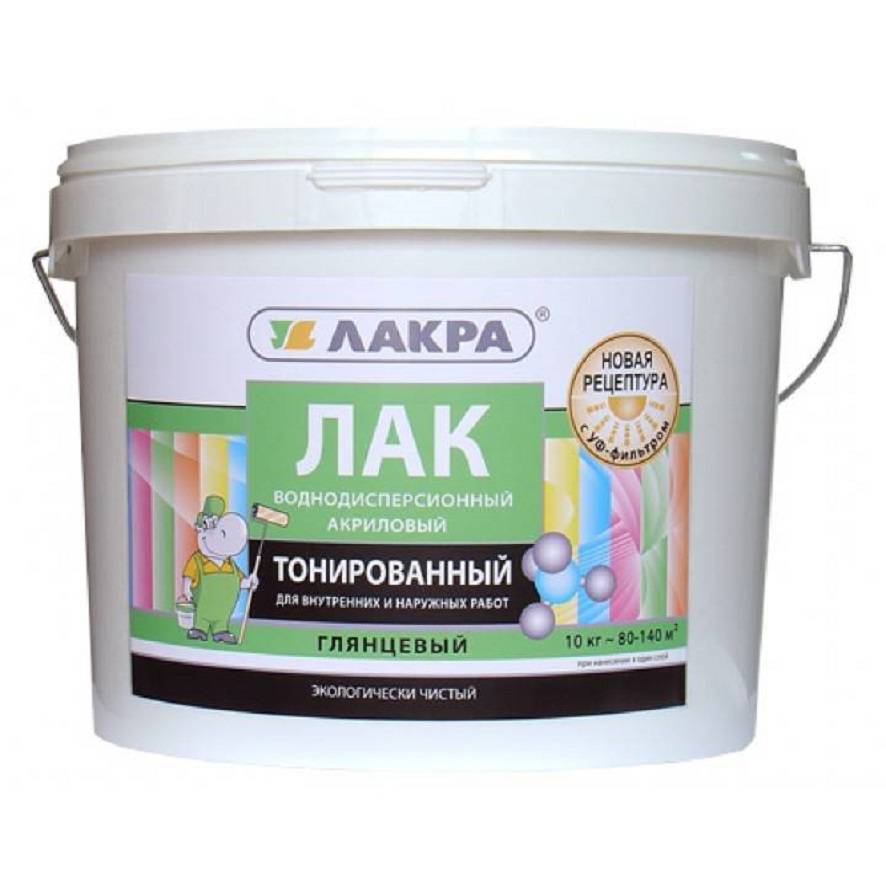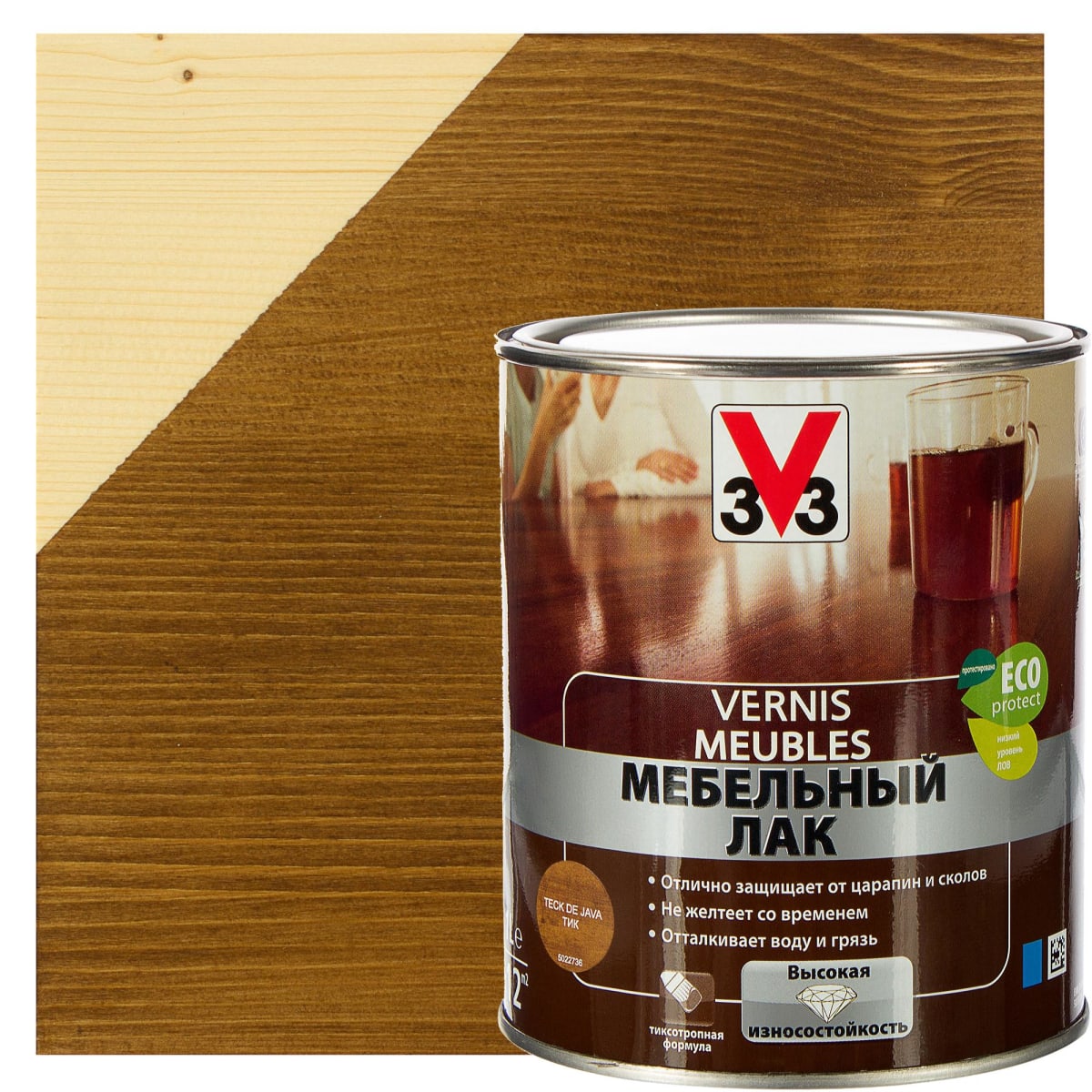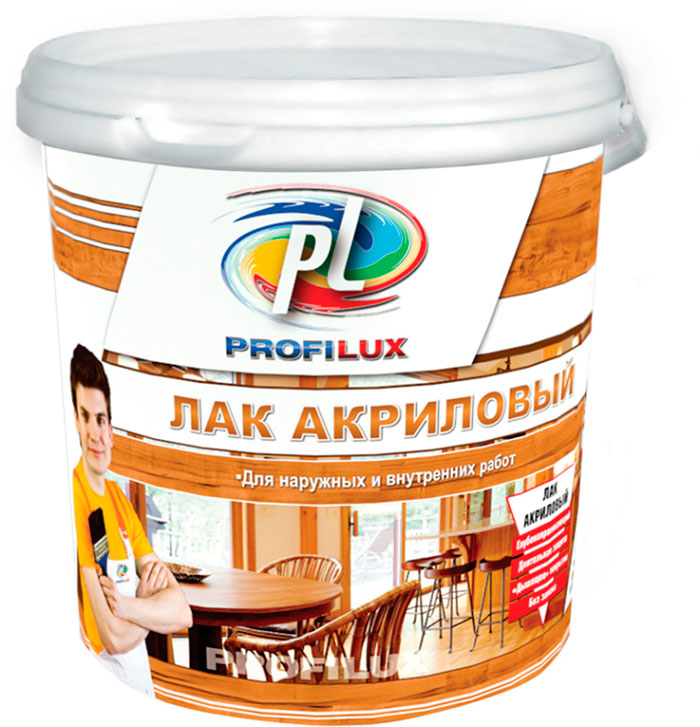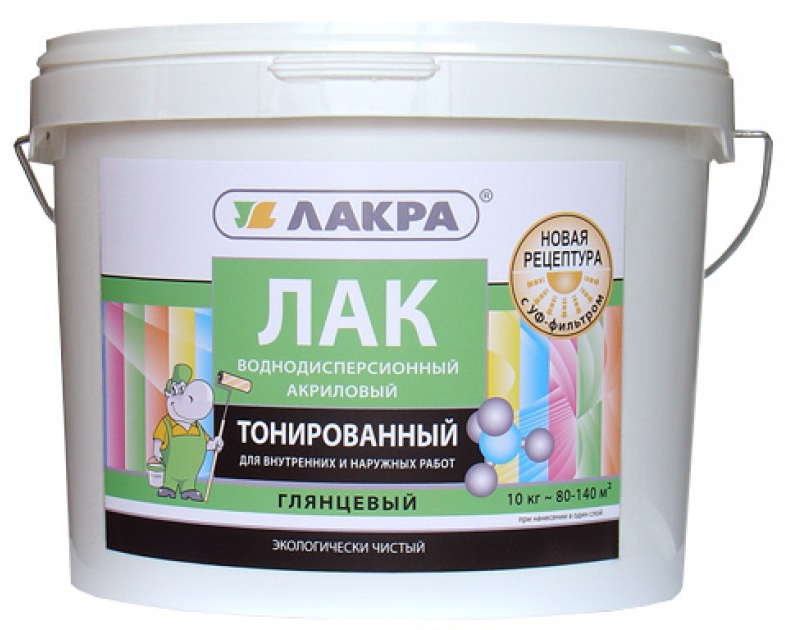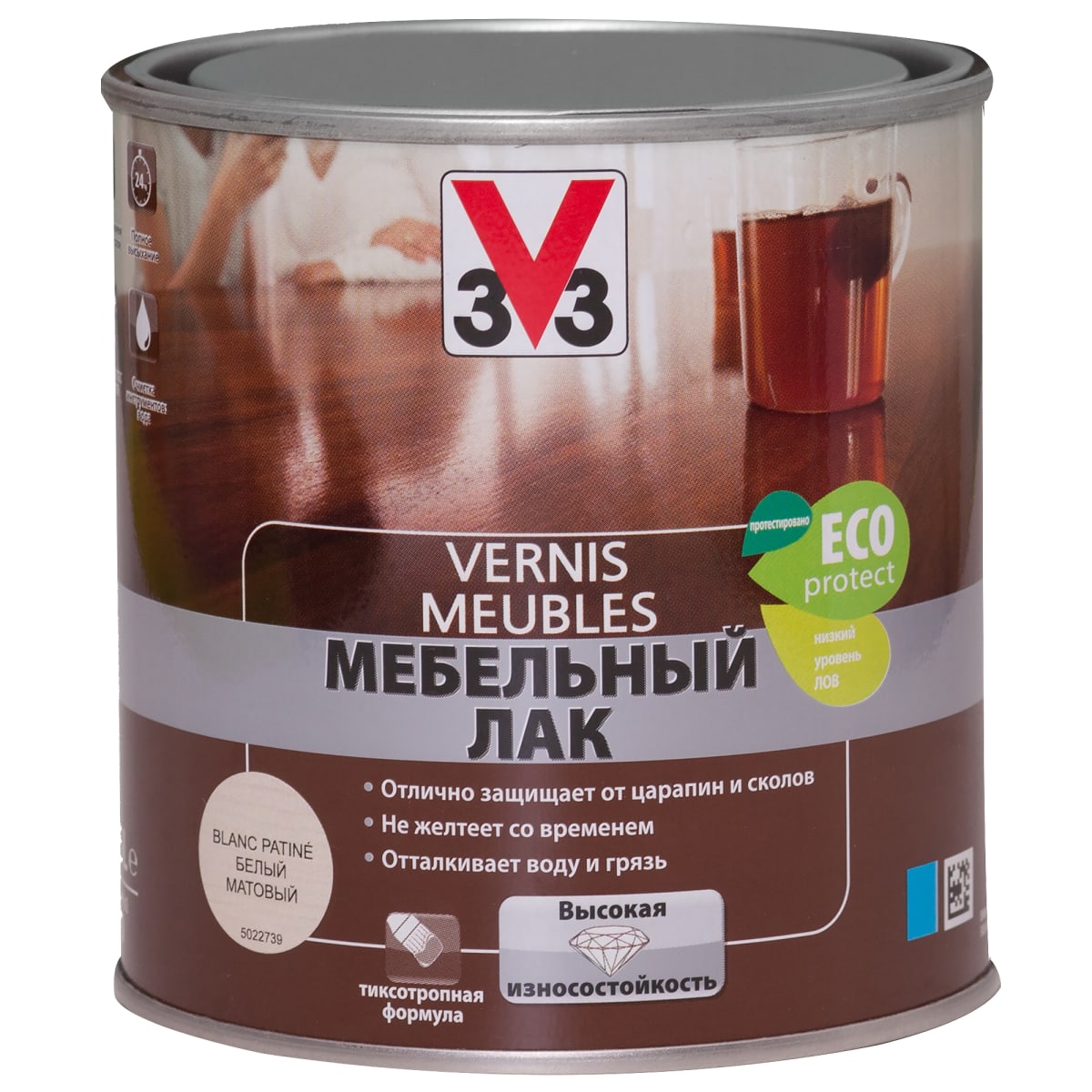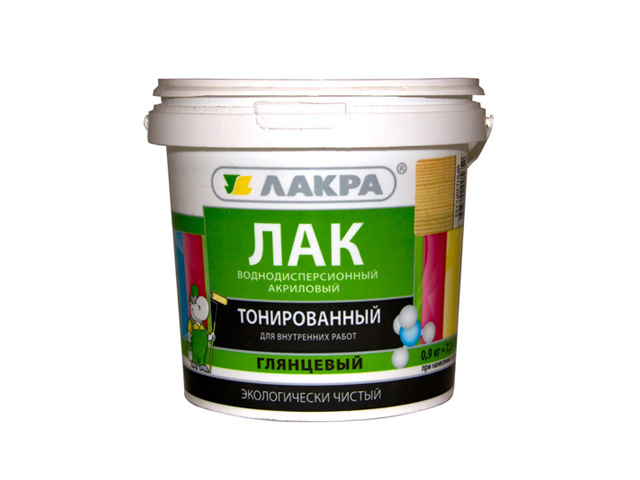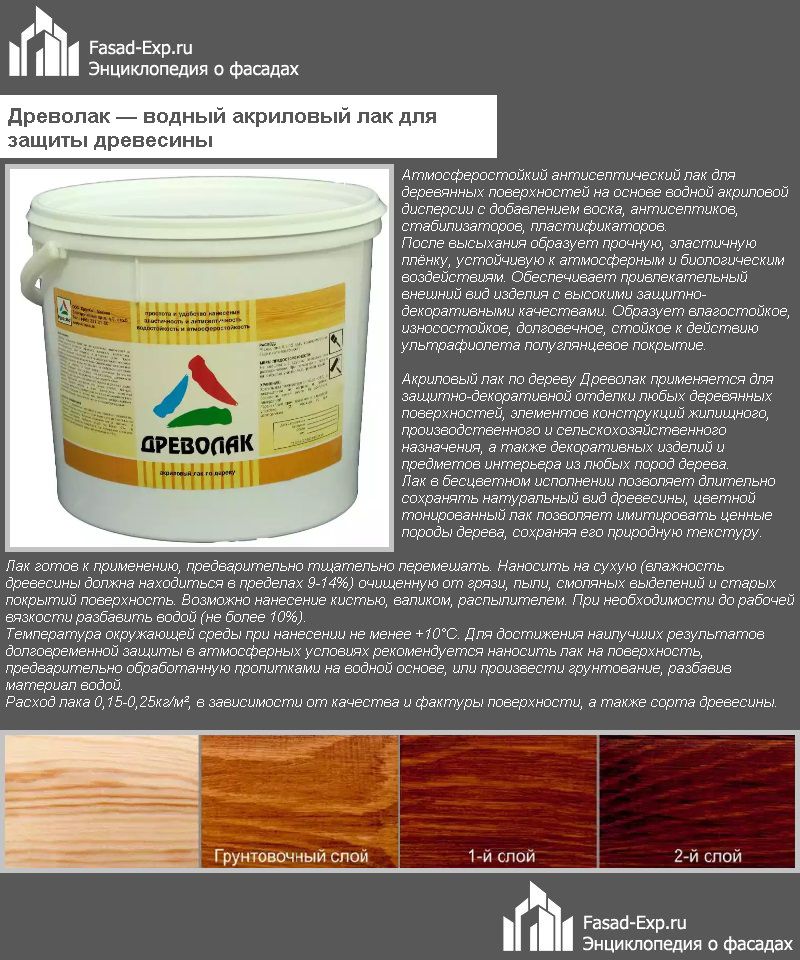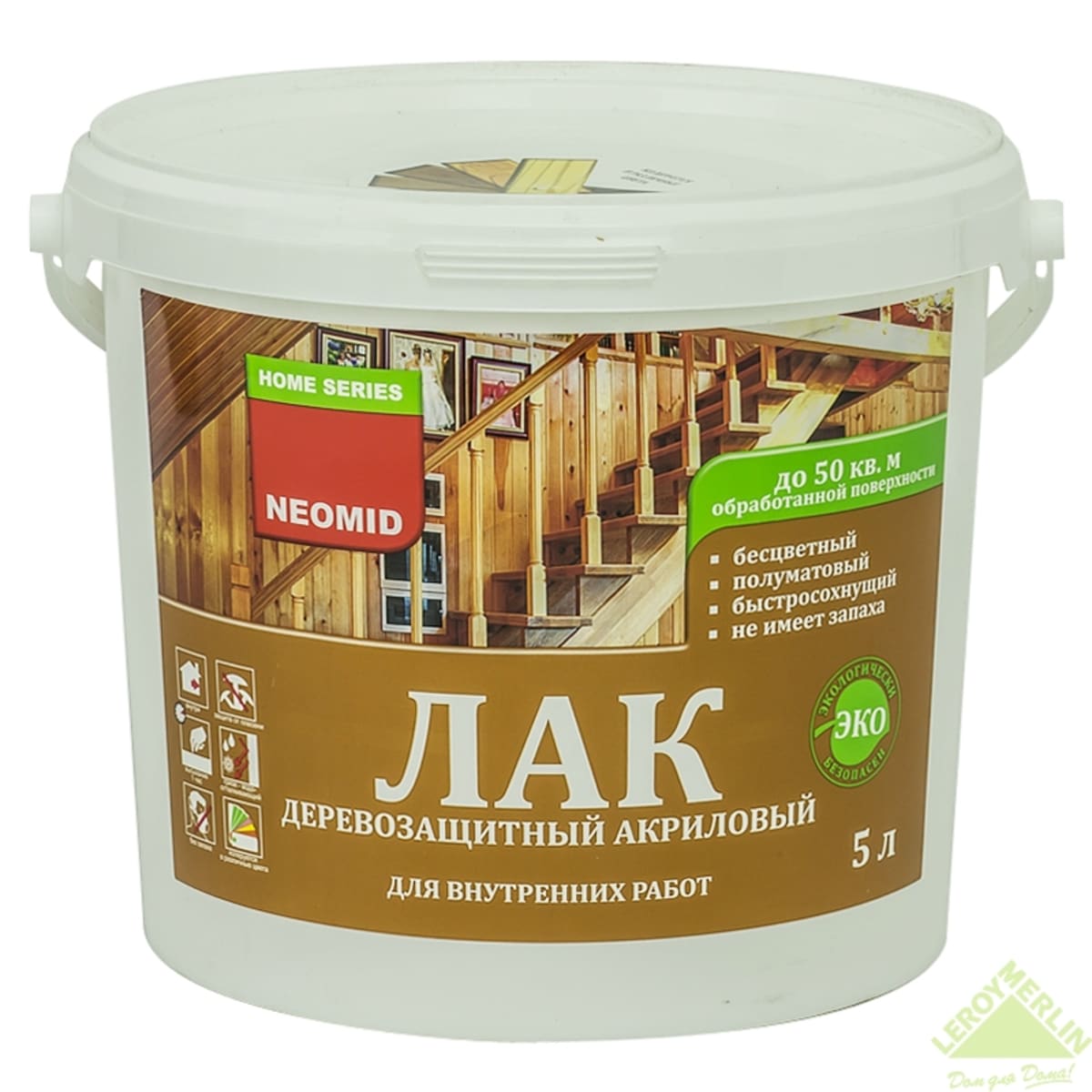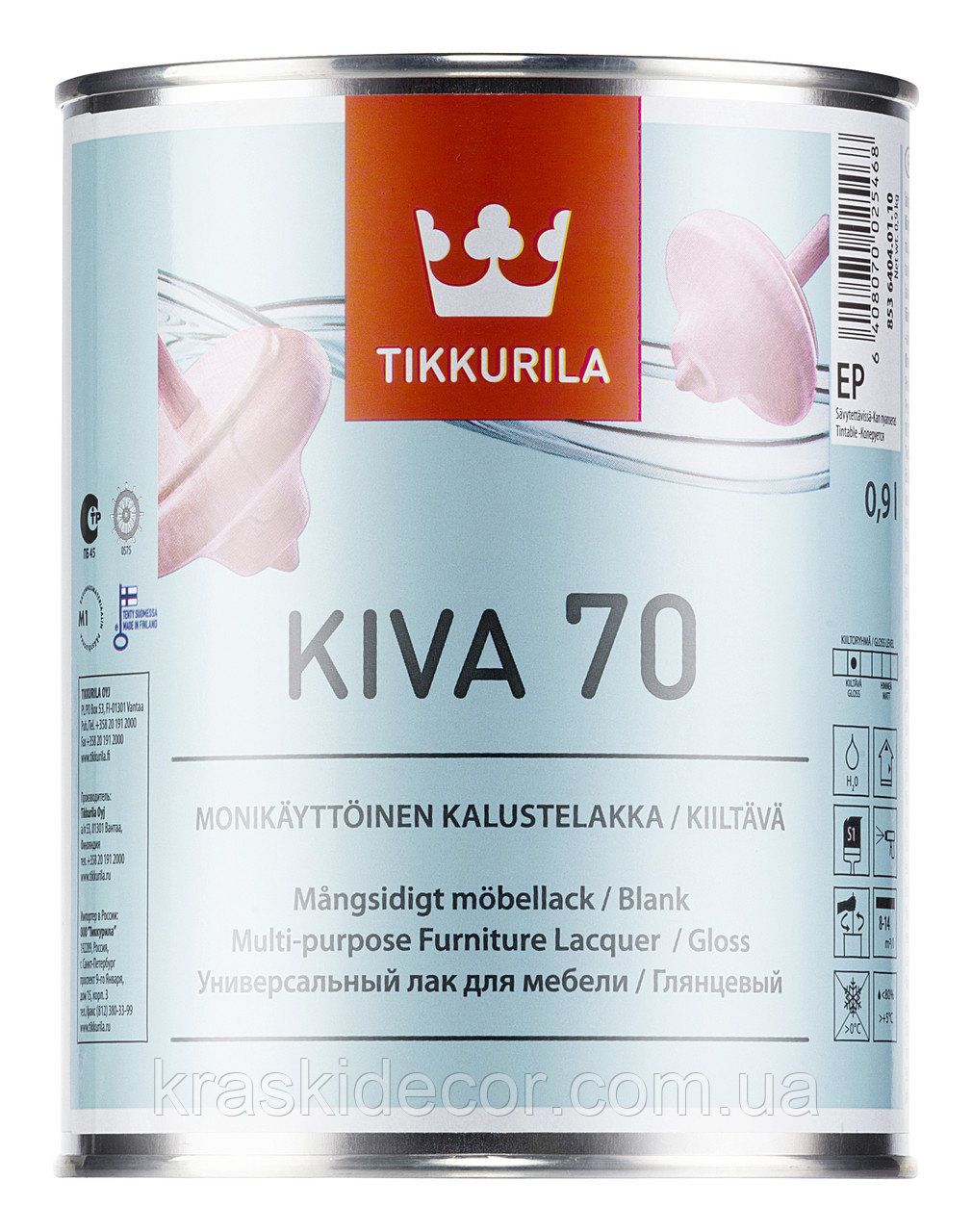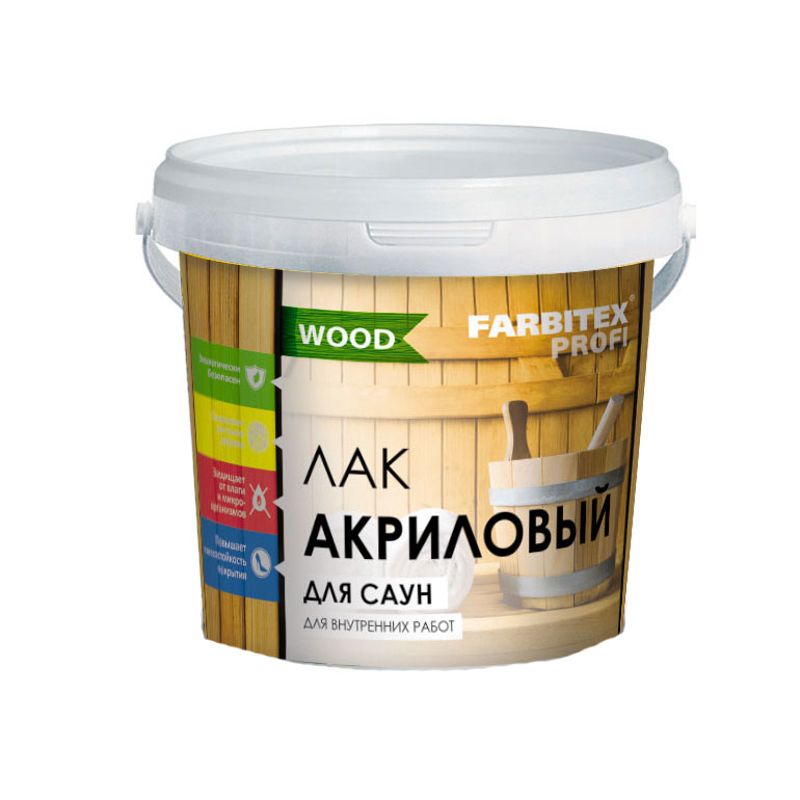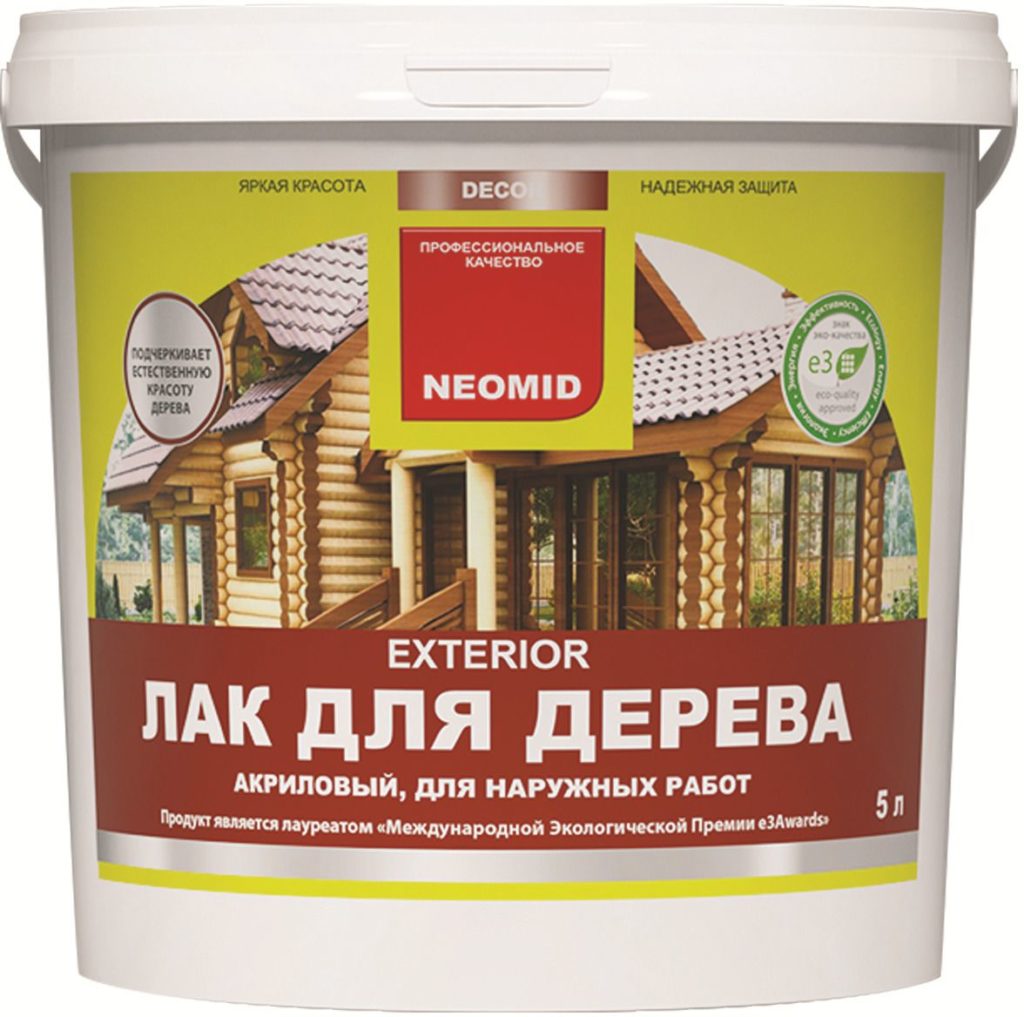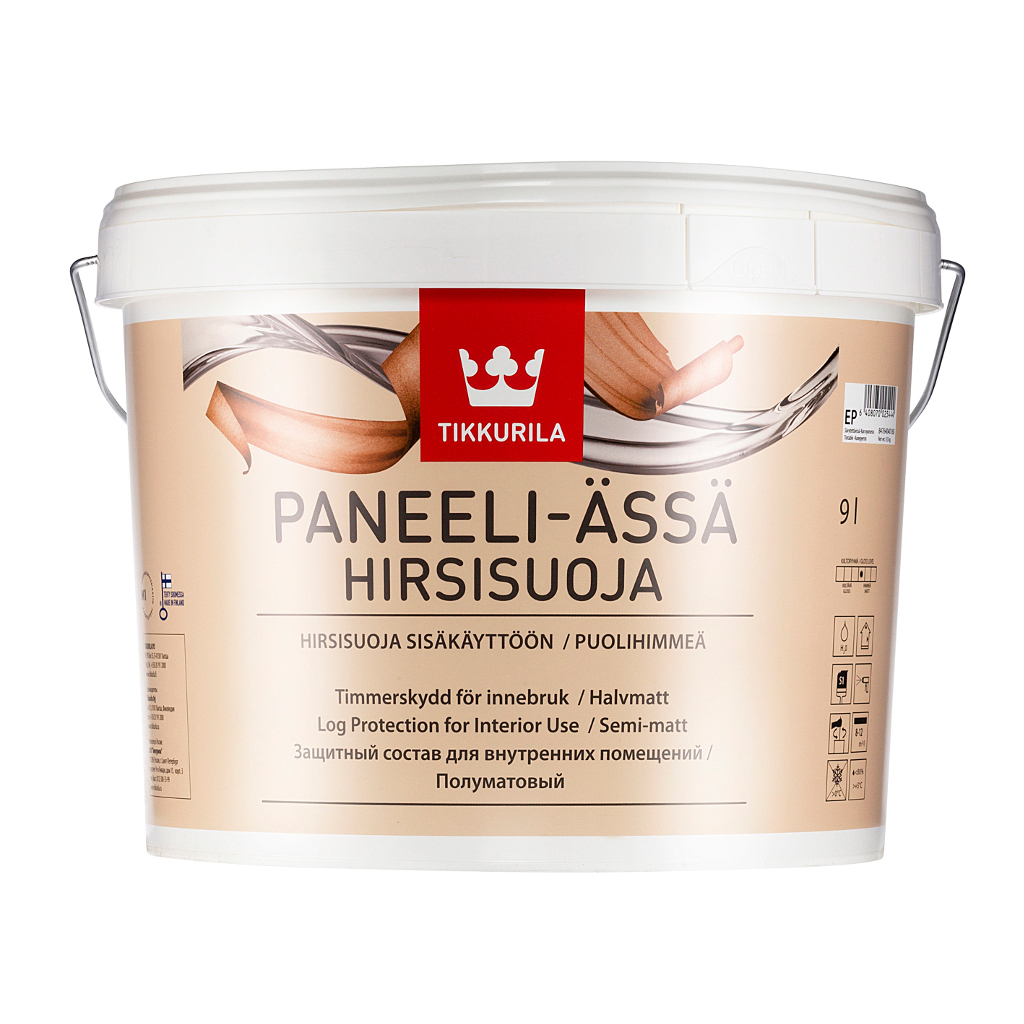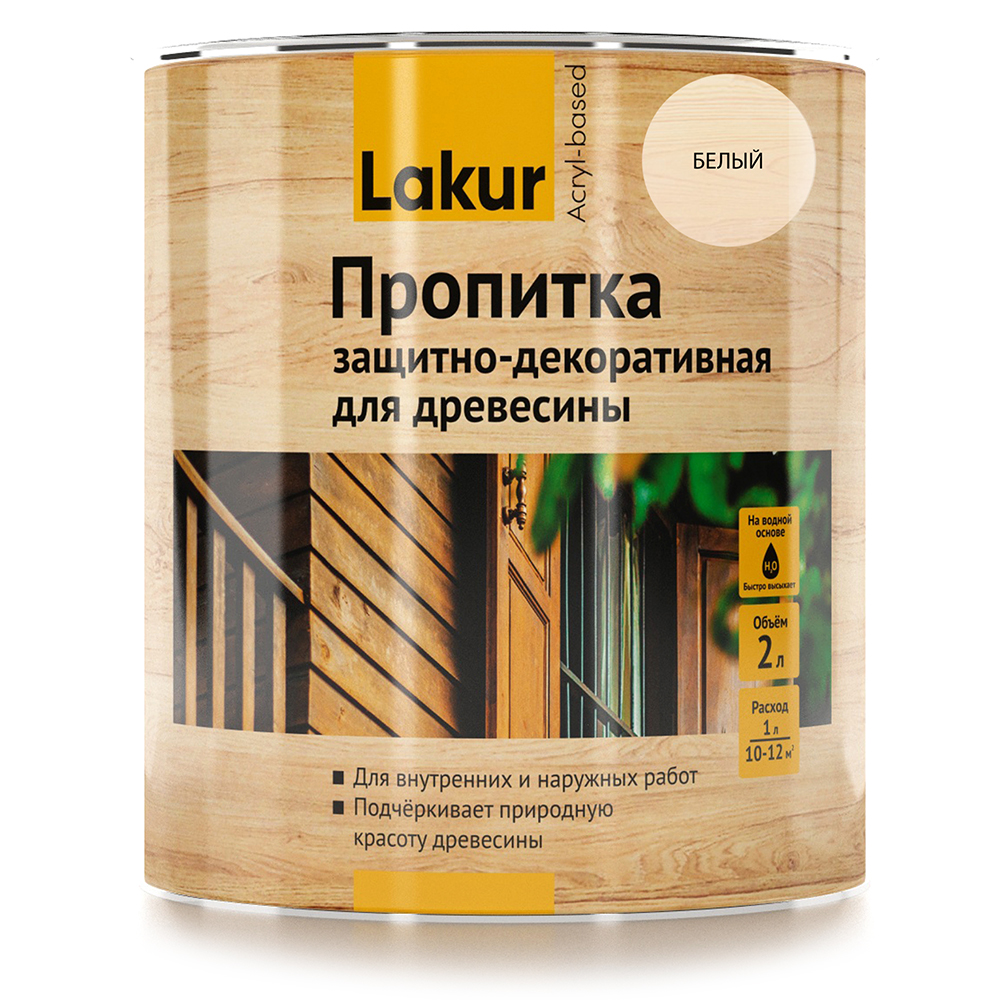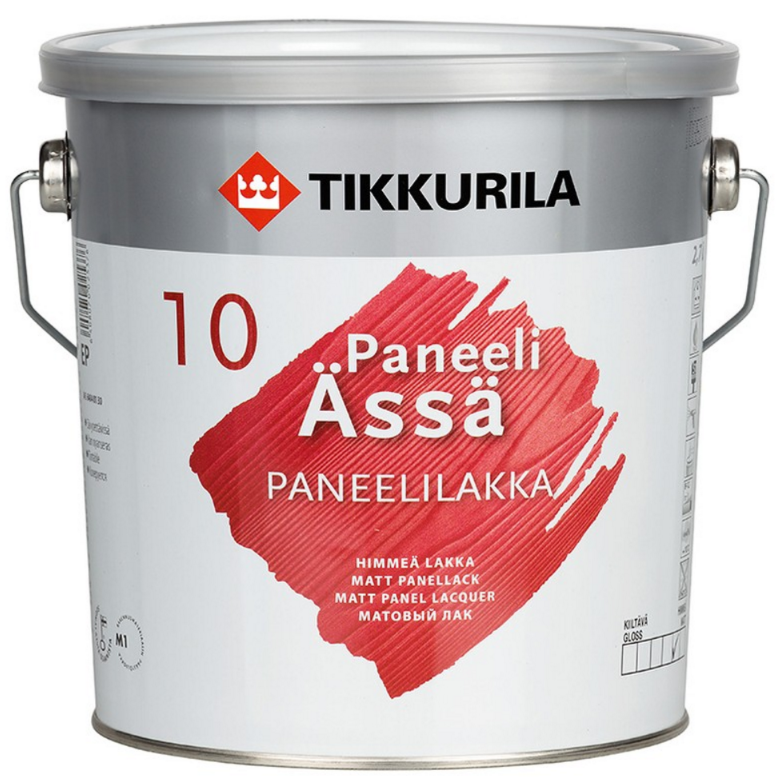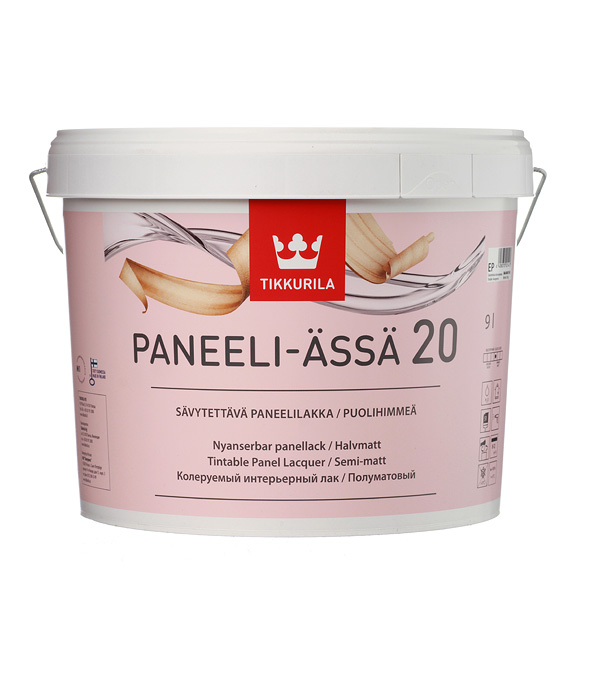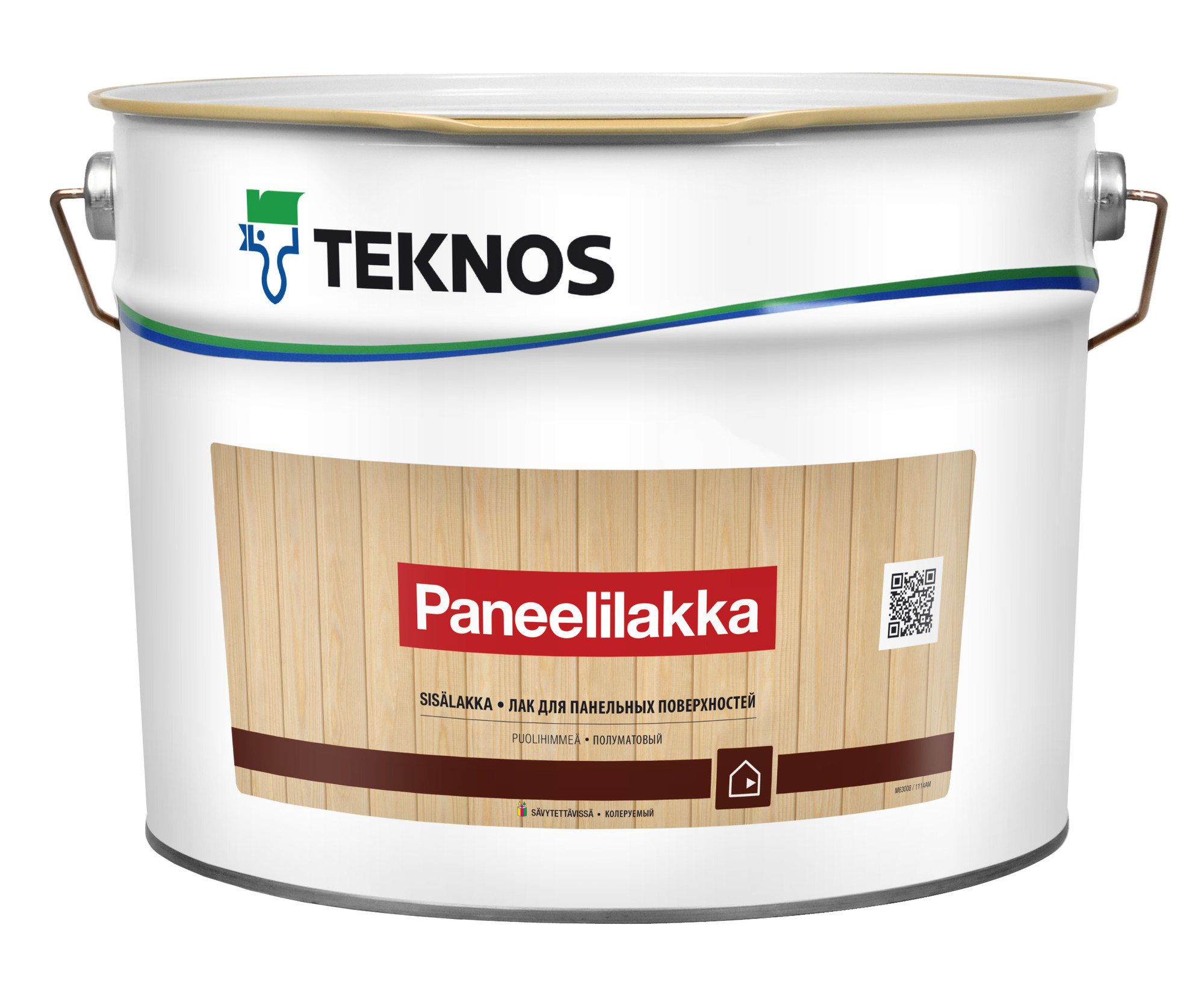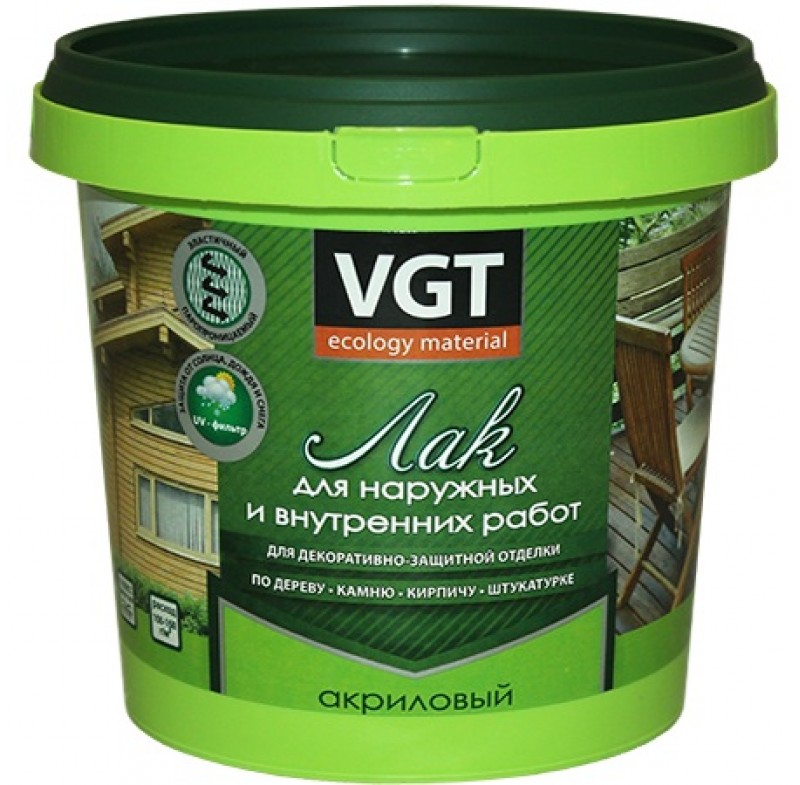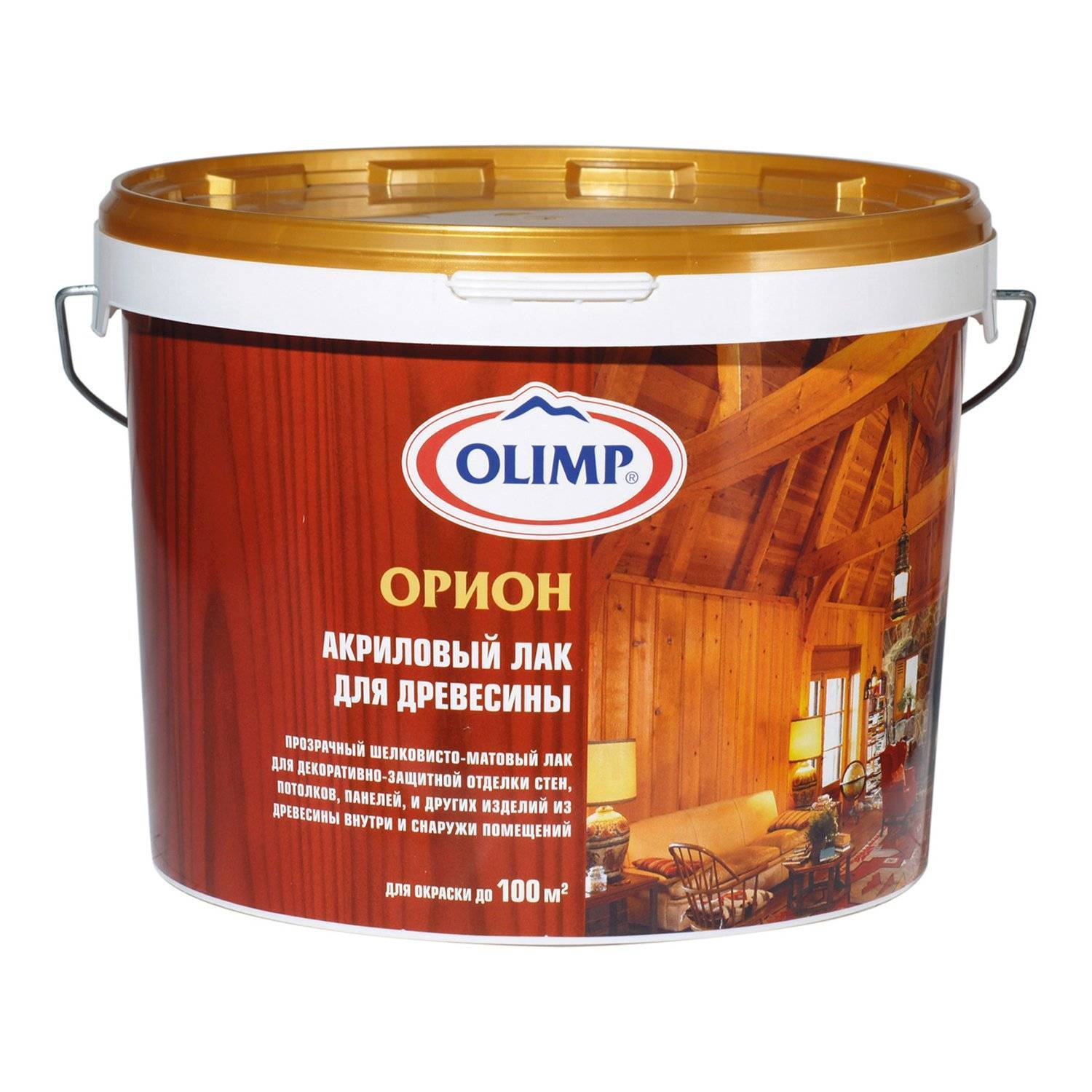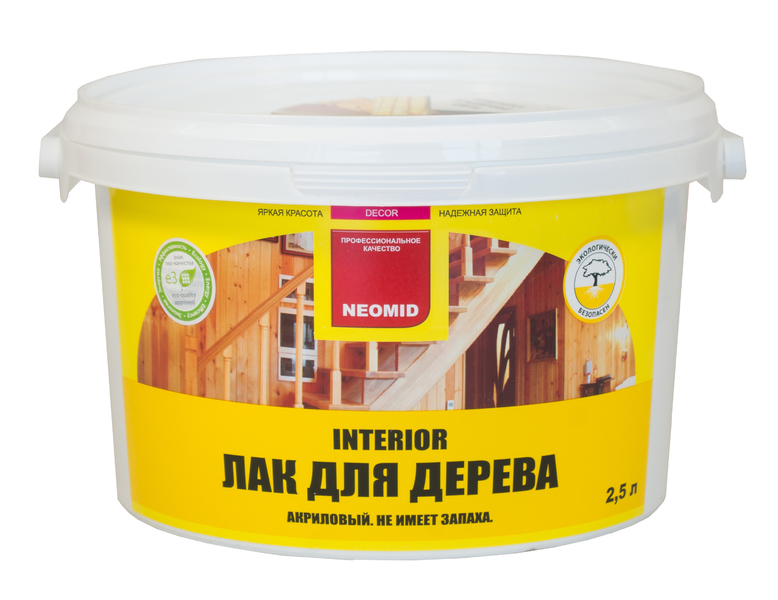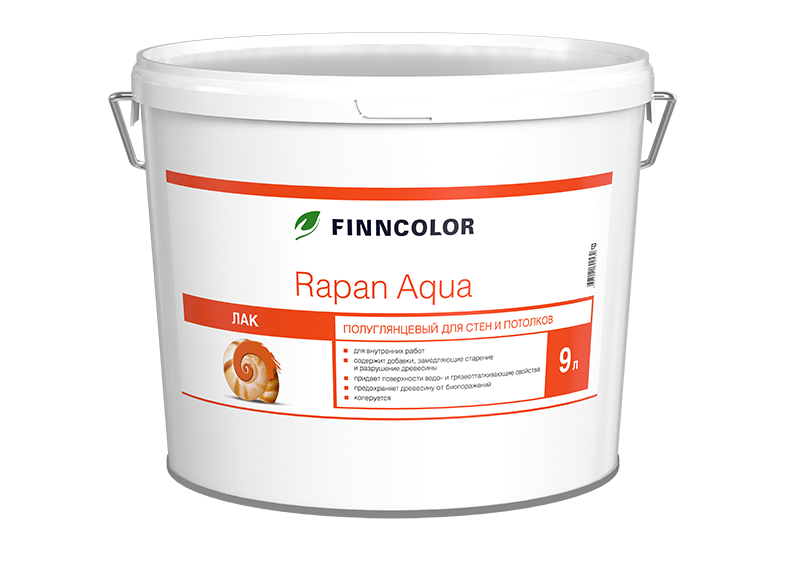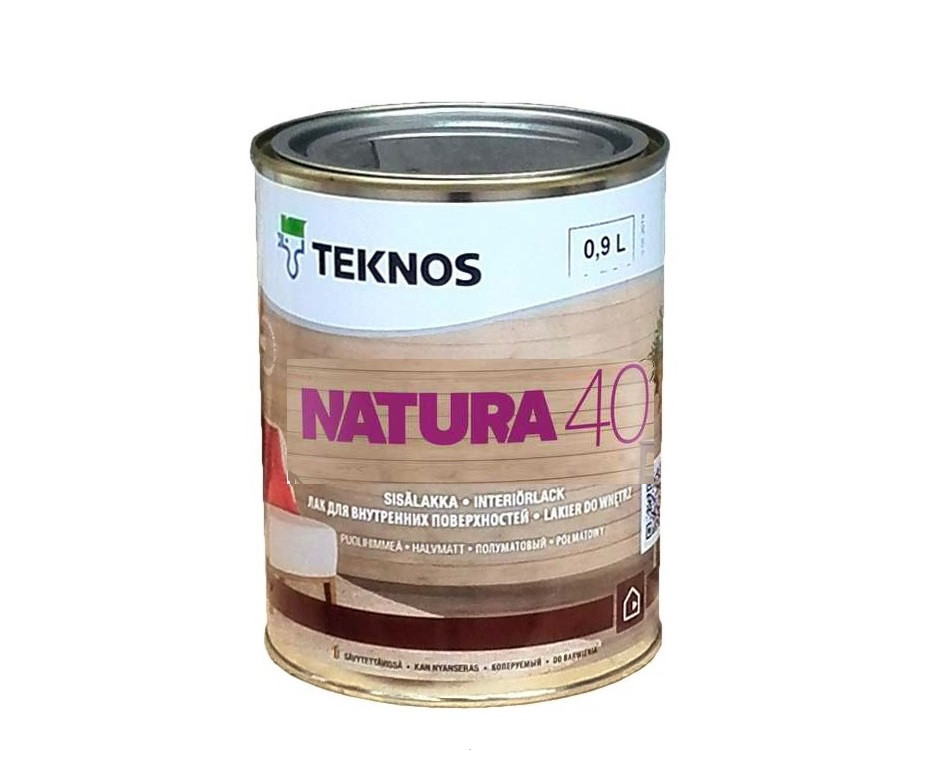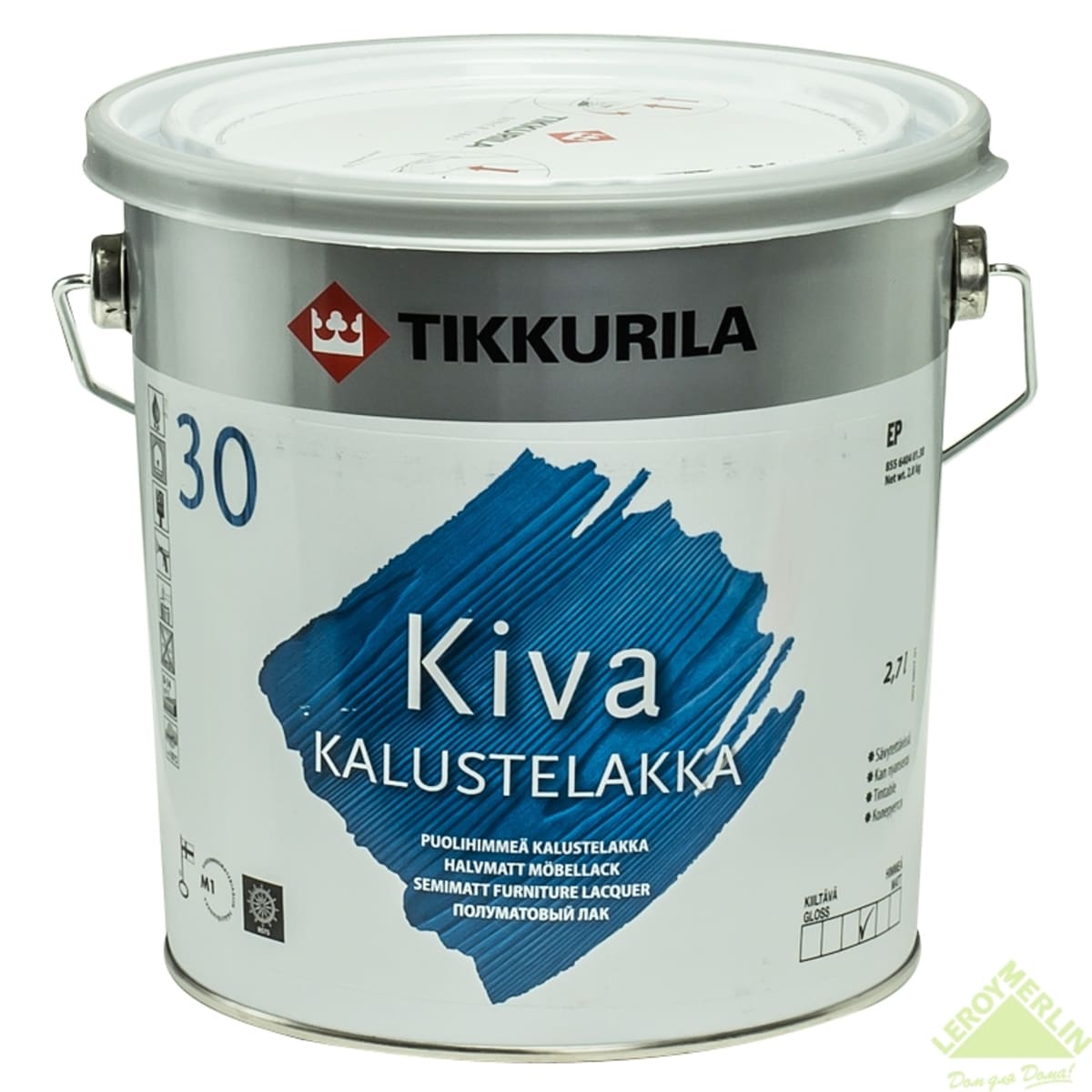Varieties and characteristics
Varnish is a substance produced as a mixture of polymers, solvents and film-forming resins. The film formed by varnishes can be different - transparent or have shades. Tikkurila products are used for surface treatment in homes, baths and saunas, terraces, boats and yachts. Some varnishes can be used to treat concrete and brick surfaces, while the consumption of varnish will differ from its consumption when covering wooden surfaces.
Depending on the application, the following main groups of Tikkurila varnishes are distinguished:
Lacquer aqua
A group of water-borne tinted acrylate varnishes. This product perfectly protects wood panels, lining and any kind of board.
An important positive point is that all products of the Lacquer Aqua line do not have a strong odor, therefore they can be used in any interior premises, however, water-based varnishes are not used to treat furniture and floors. Lacquer Aqua effectively protects wooden surfaces from temperature extremes, darkening and even moisture.
Water-based interior lacquer is suitable for any wood and is easy to tint.
Kiva
Customers often choose this tinted water-borne acrylate varnish for its excellent qualities (it does not turn yellow) and for its favorable price. Kiva is used indoors for varnishing furniture, walls, ceilings and doors. Stained and painted surfaces can also be treated with Kiva products. Since the coating does not turn yellow, thanks to it, you can preserve the color and texture of the wood for many years.
Euro kiri
They are distinguished by special wear resistance, due to which they are widely used for parquet and other wooden floors. A durable, stress-resistant coating that will perfectly cope with frequent cleaning of floors and exposure to detergents.
Oksalakka
Special varnish for knots. If you are concerned about the appearance of brown tar spots on the surface after painting the wood in the knots, then you need a special product "Oksalakka"!
This is a special composition that will not allow the resin to seep through the painted surface, just apply it with a brush to the knots before final painting.
Paneeli assa
A line of acrylate varnishes used for interior work when processing wood and brick walls. If you want to protect ceilings and walls from damage, then Paneeli Assa is the best choice.
The protective film formed during the application of the product does not leave marks from hands or small scratches from sharp objects. The color of the composition is initially white, but when it dries, it brightens and becomes transparent.
It should be noted that the Paneeli Assa line is quite diverse and includes special varnishes for light wood species and special protective agents that repel water and dirt.
Parketti assa
A range of reliable water-borne polyurethane acrylate varnishes. These products will permanently protect the wooden floor from scratches, wear and other damage, while the surfaces treated with these varnishes look environmentally friendly, natural and effective.
Taika glow
It is a unique lacquer that glows in the dark. Wherever it is not used - in the decoration of the interiors of clubs, cafes and cinemas, in bedrooms and children's rooms! It is environmentally friendly, so children can be involved in creativity.
Unica supe
Wear-resistant product, suitable for indoor and outdoor use. It is also called yacht or deck, as it is widely used for painting boats. Unica Super varnish is used to cover window frames, floors and doors, outdoor furniture and much more.
All Unica Super products are urethane-alkyd and dry fairly quickly. The tool slows down the "aging" of wood from exposure to sunlight and is not afraid of contact with water, and also protects the wood from mold, cracking and fungus.
In order not to be mistaken with the amount of material required, you should make a calculation in advance and find out how many cans of varnish you need
Please note that the packages always have data indicating how many square meters can be varnished. To do this, you need to calculate S (area of \ u200b \ u200bthe room) and correlate the information obtained with the data on the varnish package
Applying varnish to a wooden surface
The priority step prior to the application of acrylic varnish is a thorough surface treatment. From it, you need to remove everything that may interfere with the formation of an even layer. Processing takes place in several stages, the number of which depends on the characteristics of the base for painting:
- Cleaning. If the surface has already been varnished, then in addition to removing various dirt and grease stains, you will need to remove the previous layer of varnish. Before removing the old varnish, you need to make sure that the procedure does not damage the base (especially for parquet flooring, the boards of which can crack under intense exposure). Sometimes this can be simple enough; but in order to remove the old acrylic varnish, you will have to sweat a lot - it is better to stock up on abrasive paper and a sander.
- Grinding. In order to achieve a perfectly flat wooden base, you can use the "wet" method - moisten the wood and rub it hard with sandpaper. The primer and acrylic varnish then applied will form a "mirror-like" finish.
- Primer. The cleaned surface will need to be impregnated with a special compound that will eliminate all irregularities that are invisible to the eye.
If the finished composition seems too viscous, or wood processing is carried out for the first time, then you can dilute the acrylic varnish with water. However, it must be remembered that the maximum proportion of the solvent should not exceed 1/10 of the total mass. This composition is ideal for the first layer, but the second and third layers should already be undiluted.
# 1. What is the difference between different wood varnishes?
Varnish is a viscous product consisting of a solvent, resins and polymers. After application to the surface, the solvent evaporates, leaving a dense, durable film. This barrier protects the tree from all sorts of negative factors. Since wood was previously the main building material, the first varnishes appeared in the 12th century. It was the invention of a German monk, and the composition of the protective substance was kept secret for a long time. Attempts to develop a means to prolong the life of a tree have been made constantly. So, in the 15th century, oil-type compositions appeared in England, later in Holland and Portugal they began to produce varnishes based on resins.
Since then, the range of such products has expanded significantly, compositions with specific properties have appeared, so today it will not be possible to just go to the store and buy the first wood varnish that comes across - it is important to take into account the many nuances of various compositions, otherwise you can not only not protect the material, but also harm it
When choosing a varnish for wood, the following factors should be taken into account:
terms of Use. On the street, the material is affected by factors such as high humidity, constant changes in temperature and ultraviolet light, therefore, the composition for protection must be chosen appropriate - only wood varnishes for outdoor use are suitable. As a rule, the manufacturer indicates on the packaging the conditions in which the composition can be used. Parquet, furniture and wall decoration materials can be safely varnished for wood for interior work;
wear resistance. It is not always possible to cover the floor with the same composition as the furniture, since the load on the surface will be completely different.If even the least resistant nitrocellulose varnish is suitable for furniture and other wooden objects that are not subject to severe wear, then more durable compounds must be taken for the flooring;
toxicity. Most modern formulations have an unpleasant, pungent odor when dry, as they contain organic solvents. Of course, this smell will disappear when the varnish is completely dry, and until then, at best, you will get a headache, and at worst, you will get serious poisoning. Polyurethane, acrylic, polyester varnishes and nitro varnishes are applied in special protective equipment in carpentry workshops or non-residential premises. After drying, all of these compounds are safe. If the work needs to be carried out at home, and at the same time the household is not going to leave anywhere, then it is better to take the least toxic composition - these are water-based varnishes, they have practically no smell;
drying time. A coat of varnish can dry from 6 to 72 hours and sometimes longer. Water-based varnishes and oil varnishes dry the longest, alcohol and nitrocellulose varnishes - from 20 minutes. According to this parameter, all formulations are divided into slow- and quick-drying. Consider this characteristic of the varnish when calculating the duration of the work;
resistance to high temperatures. It makes sense to apply heat-resistant varnishes to wood in those rooms where the risk of fire is increased.
It is important not only to choose a suitable composition, but also to properly open the surface with it, because the result largely depends on the application technique;
shine. Thanks to varnish, you can get a glossy or matte surface
The choice in this case is based only on aesthetic preferences, since the performance does not depend little on the degree of gloss. Gloss gives visual volume, and the matte surface is able to emphasize the beauty of the wood. Gloss is measured as a percentage of reflected luminous flux. So, for example, high-gloss varnish reflects more than 90% of light, glossy - 80-90%, and matte - less than 10%. There are also semi-gloss and semi-gloss compositions, so there is a large selection;
varnish components. For performing work on your own, one-component varnishes are best suited, those that are simply applied and form a protective film by evaporation of the solvent. Professionals often use two-component varnishes, in which a protective film is formed by a chemical reaction between two substances. As a rule, such formulations are more persistent;
the need for a primer. Self-priming varnishes can be applied directly to wood. The rest of the compositions require preliminary surface preparation: if you do not prime it, then soon you can face the flaking of varnish, the appearance of cracks and craters.
You can also find toning varnishes on sale. With their help, you can give the wood the desired shade or even completely change the color. However, the classic option is still a transparent varnish, which allows you to preserve the original wood pattern.
What is acrylic paints and varnishes
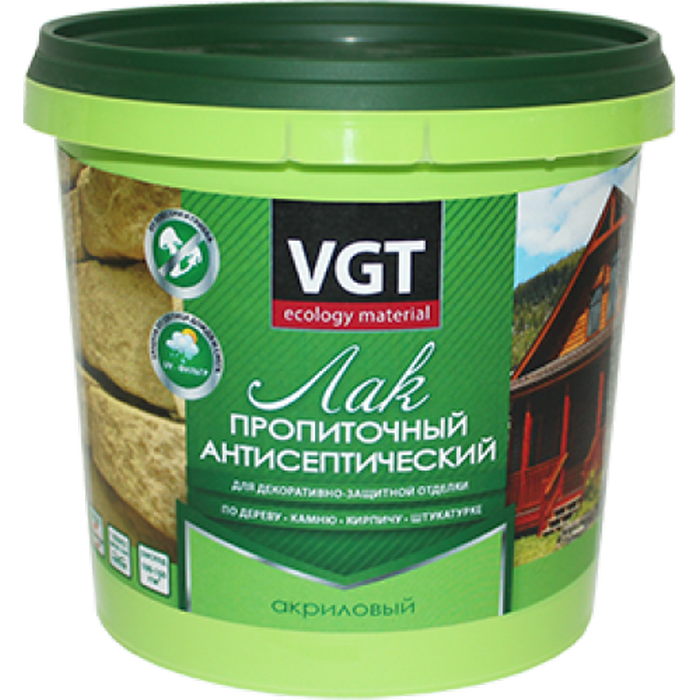 Acrylic paints and varnishes used for external or internal work are made from polymers
Acrylic paints and varnishes used for external or internal work are made from polymers
Acrylic paints and varnishes used for external or internal work in the processing of products from wood of various species, metal, glass, stone and many other surfaces, including soft canvas, are obtained from methyl, butyl or ethyl acrylates - polymers formed by esters of acrylic, methacrylic or cyanoacrylic acid.
For the first time, acrylic polymers were obtained in 1952 by one of the leaders in the manufacture of paints and varnishes, the American company DuPont, which was developing a technology for the production of a new type of material that could compete with the popular nylon in those years.The resulting material was easy to color, was resistant to ultraviolet light and acid and alkali solutions, and in a completely dried state practically did not react to prolonged exposure to water.
And who, if not the leader in the production of paints and varnishes, can use these properties to obtain durable varnishes and paints used in industry and everyday life. Acrylic paints and varnishes are widely used in the automotive industry as factory coatings and refurbishment systems, in the construction industry for interior decoration, and in the creation of durable plasters and paints for outdoor use.
The resulting polymeric materials are readily soluble in various types of solvents. Organic solvents allow you to adjust the drying time and temperature conditions for the use of paints, and the water-based varnish is practically odorless and can be used for surface treatment in child care facilities and for painting toys. It is easy to apply to the surface, and after drying it can only be removed with a special solvent.
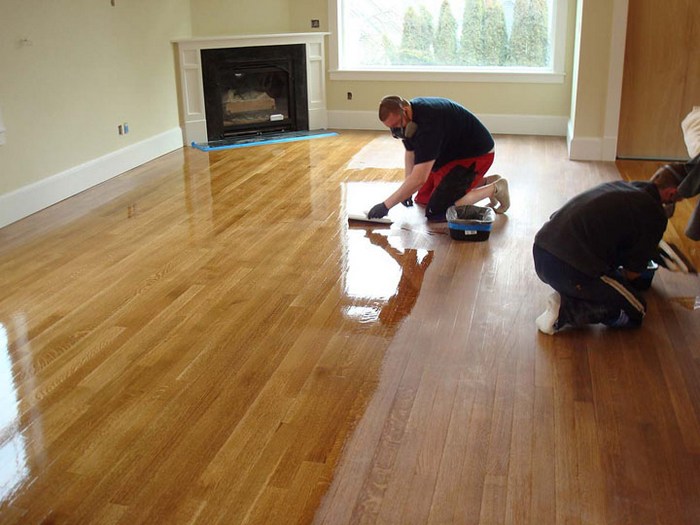 Paints and varnishes based on acrylic polymers made by various manufacturers have excellent protective properties
Paints and varnishes based on acrylic polymers made by various manufacturers have excellent protective properties
Paints and varnishes made by various manufacturers based on acrylic polymers have excellent protective properties, which lead to their widespread use:
- Good adhesion to most types of materials, with the exception of some "fatty" polymers such as polyethylene;
- Short drying time;
- Compliance with the latest environmental requirements;
- Resistance to water and most solvents after complete drying;
- High strength and elasticity of the resulting film;
- The ability to absorb into wood fibers, creating a thick protective layer;
- Long service life, reaching 10-15 years when covering external surfaces.
As the reviews show, it is high environmental friendliness that consumers put in the first place when choosing paints and varnishes.
Different varnishes are needed, different varnishes are important
In its most general form, varnish is a liquid solution of various resins, which is applied in a thin layer to various surfaces and, after drying, gives them shine and protection from external influences. With the help of varnishing, a significant aesthetic effect is achieved, the service life of many products and the durability of repairs are increased. According to the area of use, varnish compositions are very diverse:
- Furniture - used indoors to cover any wooden products (not just furniture), often act as a finishing layer after sealing cracks in a log. They can contain coloring pigments immediately or be supplemented with tinting before use, thereby immediately giving the wood the desired shade already during the varnishing process. They are economical in cost, but have low wear resistance;
- Parquet. Used on natural wood floors, including those already processed at the factory. Parquet varnishes are compatible with the parquet itself, solid boards and ordinary floorboards. Their cost is quite tangible, as is their high abrasion resistance. The unifying property of furniture and parquet varnishes is low moisture resistance - that is why parquet, furniture and varnished floors are recommended to be wiped with mastic or special compounds, and not washed with buckets of water;
- Yachting. They are antipodes of their predecessors in terms of moisture resistance, because they can resist for a long time to prolonged exposure to sea spray, salty winds and ocean waves. They are used not only in shipbuilding, but also in overland maintenance and repair business, for example, when varnishing garden furniture, gazebos, wooden canopy racks or carved platbands outside windows. The cost of yacht varnish is several times higher than the price of parquet varnish, so you need to use it wisely and carefully;
- Versatile or decorative.They occupy an intermediate position between the above-mentioned compositions, they can be applied inside and outside the premises, they have moderate durability and cost.
Varnish for water-based paint, most often, is just universal. The area of decorative application of water-based acrylic paints is very wide, they are excellent for both interior renovation and exterior design, therefore, the protection of these paints should have universal properties.
Types, brands and price
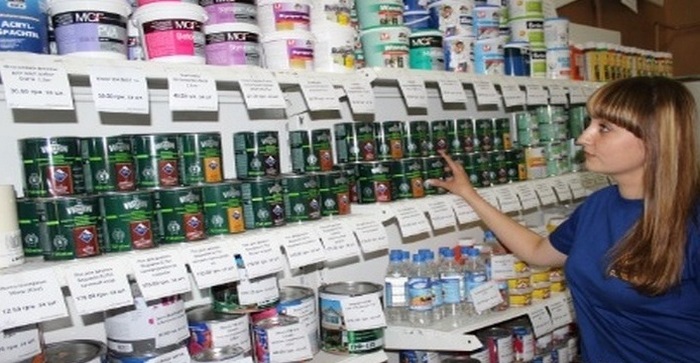 Trading networks offer a huge variety of acrylic water-borne paints and varnishes
Trading networks offer a huge variety of acrylic water-borne paints and varnishes
Trading networks offer a huge variety of acrylic water-soluble paints and varnishes for any type of work, from numerous domestic and foreign manufacturers. With external similarity, the price of various samples may differ significantly. Let's try to sort out all this abundance in order to find the right product.
Glossy, semi-matt or matte
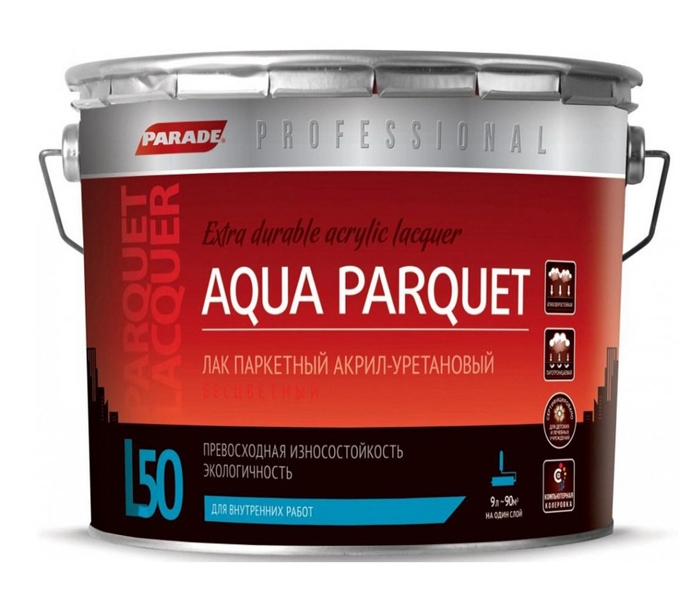 Glossy varnishes give the surface a unique shine
Glossy varnishes give the surface a unique shine
To create the required appearance and a high-quality protective film on the surface of wood or metal, manufacturers offer glossy varnishes with a gloss degree of 64-72%, semi-gloss varnishes - up to 49%, as well as matte and semi-matte compositions with a gloss degree of 26% or less. Regardless of the degree of gloss, acrylic varnishes, penetrating deeply into the wood pores, are a quality tool for the final processing of wood. Glossy varnishes give the surface a unique shine, and matt varnish emphasizes the beauty of the wood, without changing its color, but only creating a durable invisible protective film.
One- or two-component
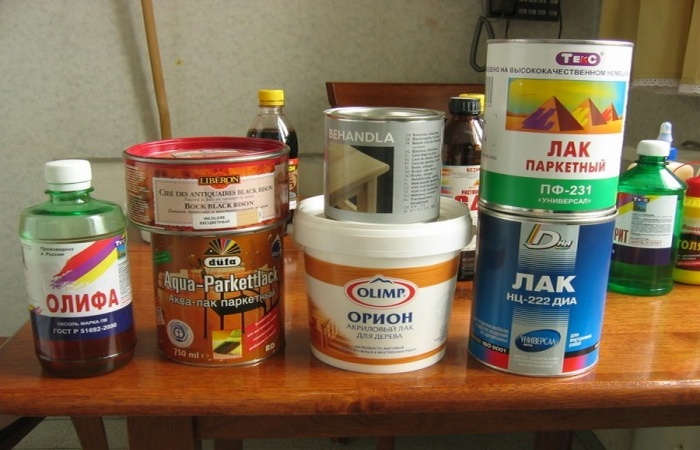 The most common water-based one-component acrylic varnishes
The most common water-based one-component acrylic varnishes
The most common one-component, water-based acrylic varnishes, completely ready for use. Their price is lower, and it is easier to work with them even for an inexperienced master. The "life" of such compositions is limited only by complete drying of the solvent, that is, water. Two-component varnishes are made to impart special properties to a polymer composition designed to protect wood in conditions of high humidity or abrasive load.
These materials contain additional additives that require the addition of a hardener for polymerization. Their price is higher, and it is more difficult to work with them. After mixing the components, the life of such a varnish is limited, which imposes certain requirements on the speed of work and the qualifications of workers.
Manufacturers
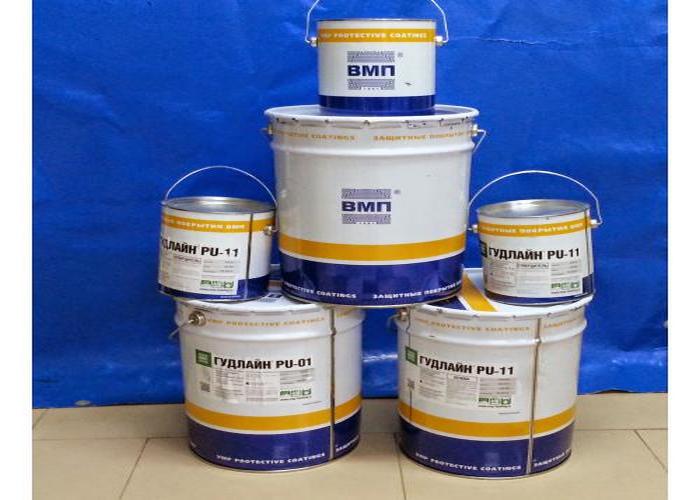 Trade networks offer a large amount of water-based acrylic varnish from a wide variety of manufacturers.
Trade networks offer a large amount of water-based acrylic varnish from a wide variety of manufacturers.
Trade networks offer a large amount of water-based acrylic varnish from a wide variety of manufacturers. Here are both eminent foreign firms and domestic manufacturing companies, stepping on the heels of their foreign competitors. The price of imported goods is much higher, but this does not mean its high quality.
The famous brands "Marshall", "Tikkurila", "Dulux", "Alpina", "Akzo Nobel" cost three times more than the same high-quality varnish made of high-quality materials from the domestic companies "Chief Technologist", "Tex" or "Neomid", the price of which is $ 10-15. per kg.
When buying a water-soluble varnish, it should be borne in mind that there are many products with a "narrow" specialization. Bathrooms and saunas have their own materials, for parquet - their own, with the necessary properties. Accordingly, their price is also different, even within the same brand.
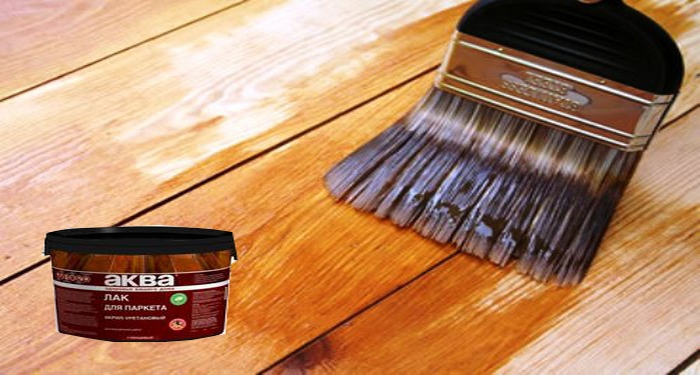 Acrylic water-based paints and varnishes are widely used in construction and repair work
Acrylic water-based paints and varnishes are widely used in construction and repair work
Acrylic water-based paints and varnishes are widely used in construction and repair work,when painting industrial equipment at enterprises with increased environmental requirements and even when painting the bodies of modern cars, displacing varnishes and paints based on organic solvents that are hazardous to health. As the reviews show, about 60-65% of buyers choose water-soluble materials.
Varnishing functions
 Varnish can be used to cover walls made of artificial stone
Varnish can be used to cover walls made of artificial stone
With the help of varnishing, a whole range of different goals is achieved:
- Strengthening the varnished surface. In this case, varnishing plays the role of an adhesive composition that holds together small weakly adhering or peeling elements.
- Protective function. The varnished surface has increased resistance to aggressive external influences - household chemicals, changes in humidity, temperature, etc. Surfaces painted with non-waterproof compounds, after varnishing, can be wet cleaned without fear of washing off the paint.
- Antiseptic action. Protects the treated surface from the development of fungi and mold.
- Maintains the saturation and brightness of colors. Covering the painted surface with a thin layer, you create a translucent film above it, which “cuts off” the excess ultraviolet radiation. Thus, the sun's rays become less damaging to the pigment of the dye formulations.
- Decorative qualities. Decorative varnish, depending on the type, can give the surface treated with it additional decorative properties: shine, dullness, color tint, etc.
Advice
Experts recommend following a few tips when using water-based varnishes.
To obtain a flawless result, as well as to maintain the performance characteristics of the varnish, it is important to prepare the working bases in advance. They must be even, clean (free of grease stains and traces of the previous coating), dry.
Primer is applied first
This stage of work must not be skipped; the primer should be applied in 2-3 layers, which will reduce the consumption of varnish and increase the strength of its layer.
It is recommended to use special primers intended for the surface to be finished, for example, for wooden surfaces, a wood primer should be used. It is important to choose compatible primers and varnishes. They both need to be water based.
- Water-based varnishes cannot be applied with brushes. For these purposes, only a roller is used; on large bases, a spray gun can be used. The use of a brush threatens the appearance of noticeable stripes on the varnished surface, therefore, rollers of appropriate sizes are used even in corners and in other hard-to-reach areas.
- Before applying each subsequent layer, you must wait until the previous one is completely dry. Otherwise, unevenness and roughness of the surface cannot be avoided. If this recommendation is followed, but the dried varnish layer is rough, then this is due to the deposition of dust on the varnish. This problem can be eliminated by grinding the surface with a defect.
- Before use, acrylic and polyurethane varnishes must be thoroughly mixed or shaken for 2–8 minutes, depending on the volume of the container with the varnish.
- Water-based varnish application is permissible only at temperatures not lower than + 12 ° C and not higher than + 30 ° C. Experts believe that the optimal range is + 20-23 ° C. Failure to comply with this requirement is likely to reduce the adhesive properties of the product. Changes in temperature during the drying process of the varnish usually leads to an increase in drying time and curing.
- When painting furniture, it is recommended to disassemble it if possible. This will allow for a better varnish application.
- If, after mixing, the composition seems too thick and inconvenient for application, it is permissible to add water to it, but not more than 10-15% of the total volume.
- If it is necessary to tint or renew the surface, you can use the color scheme. It must be thoroughly mixed with varnish, otherwise more and less bright colored stripes cannot be avoided when painting.
- Water-based varnish can be tinted only by impregnation on a similar basis. First, the test part of the varnish is prepared - a dye is added to a small amount of it with drops. After mixing, if the shade of the composition suits, it is checked on a separate area of the surface.
- The bases can be tinted with a spray gun or foam swab. This will allow for a more even layer. With different thicknesses of the applied layers, the shades in the thicker area will be darker. Experts recommend painting surfaces in 2-3 layers, applying them as thinly as possible.
- When varnishing the plastered walls, it is recommended to first wax them. This will reduce the consumption of varnish and will allow you to get a noble shimmering surface that changes its appearance depending on the angle of illumination.
- Before applying the finishing layer of varnish, it is worth walking over the surface with sandpaper, and then dust it off. This will avoid the formation of bubbles on the last layer.
- During work, as well as during the drying period, the windows should be closed. This will prevent dust from settling on the sticky surface.
In the next video, you will find a comparative test of water-based varnishes.
Manufacturers
Many companies in Russia and abroad produce acrylic varnishes. In the modern market, the attention of buyers is offered goods of different brands. The most famous of them are presented below.

"Chief Technologist"
The line of paint and varnish materials "Chief Technologist" is produced by the enterprise from "NovBytKhim". A significant advantage of the manufacturer is its own research laboratory. Acrylate varnish for wood is suitable for indoor and outdoor work in the conditions of the average Russian climate. They can be used to coat already painted surfaces with water-borne paints.
The coating dries within 2 hours at room temperature and normal humidity (40-60%), it is consumed economically. Manufacturers recommend using paintwork materials at temperatures above 10 C. After applying each layer, it is necessary to let the previous one dry for an hour. In a closed state, the composition is stored for up to two years. The varnish is produced in buckets with packing of 0.5, 1, 2 and 10 kg. The color range is represented by 12 shades of the most popular tree species (maple, beech, pine and others).

VGT
VGT products receive good customer reviews. The two factories have their own laboratory and are engaged in the production of a wide range of materials. VGT varnish is intended for antiseptic surface treatment. Due to its composition, it penetrates deep into the base, ensuring the safety of the surface. It is applied in a thin layer in the form of an elastic film.
It can be applied with any tools, it has a low consumption (from 100 to 160 g / m2). The layer ceases to adhere within 1 hour. Complete drying takes place after 2 days. The composition is presented in 12 shades. It is recommended to apply it at a temperature of 7 degrees C and above, as well as sufficient air humidity. Stored under normal conditions for 24 months. Available in 0.9, 2.2 and 9 kg formats.
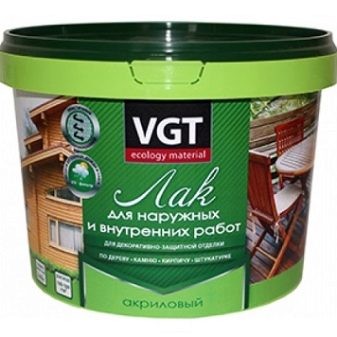

Tikkurila
Tikkurila is a well-known Finnish brand with a century and a half history. Since 1995 the company has been operating in Russia. The products have long gained popularity in the Russian and world market of paints and varnishes. Finnish quality makes Tikkurila varnishes popular in the construction market. Acrylic compounds are available in several versions.
There are glossy, matte, semi-glossy textures. The varieties have good protective properties, they are perfectly aligned when applied. Material consumption is moderate: from 8 to 14 sq. m / l. The brand varnish dries completely in 24 hours. On store shelves, it is sold in cans of 0.9, 2.7 and 9 liters.The only drawback of this product is the high price.
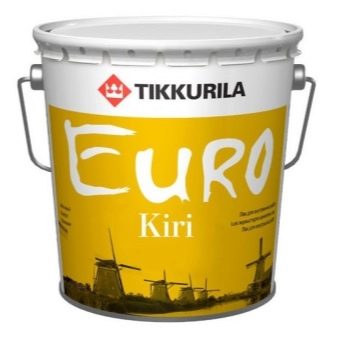

"Lacra"
The Lakra group of companies is one of the leaders in the Russian production of acrylic varnishes. Thanks to the manufacture of products in many European countries, their quality meets the highest standards. These compositions are applied with a brush or spray gun, they have a small consumption (from 8 to 14 sq. M / kg). The assortment includes all variants of textures, the products have an attractive price and are sold in two versions: 2.5 and 10 kg.
The hermetic product is stored for up to two years. Dries after application in 5 hours, hardness takes another 3 hours. The surface is completely ready for use after 7 days. The company's paint and varnish materials are distinguished by good performance characteristics.
Eurotex
Eurotex acrylic varnish for wood is a product of a Russian brand. It guarantees the protection of the array from various kinds of microorganisms, moisture and temperature fluctuations. These products can be used for outdoor and indoor use. Paintwork materials are packaged in packages of 0.9, 2.5 and 9 kg. The trademark acrylic varnish is economically consumed: 1 kg is enough to process 20 sq. m of surface.
The company's products receive a lot of positive feedback from buyers and craftsmen. Among other comments, the durability of the applied layer is noted.
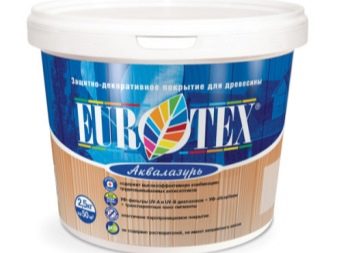

Pinotex
Pinotex products are used for interior and exterior wood surfaces. The material is sold in containers weighing 1, 3 and 10 kg. The acrylic composition is consumed economically: it is able to cover up to 18 sq. m base with one kg of mixture. The manufacturer focuses on the high environmental friendliness of the product, its safety, which is reflected in the rather high cost. The glossy varnish has antiseptic additives, is environmentally friendly and can be easily applied using any type of tool from a spray gun to a brush. Products are constantly being improved, improving technological characteristics.
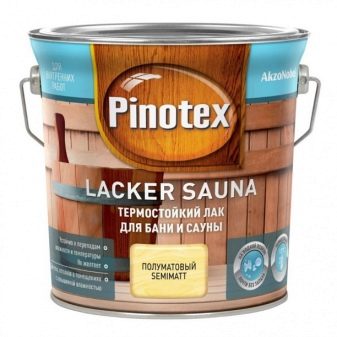
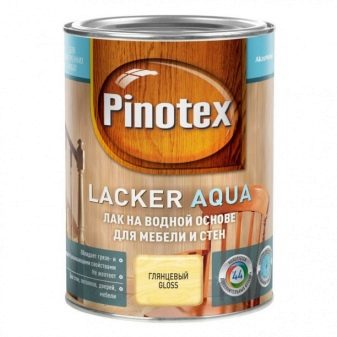
Useful Tips
To optimize varnish consumption, a surface primer is recommended.
To do this, you can apply an aqueous primer or tinted impregnation.
If the target is a “mirror” surface, a “wet” sanding should be done prior to priming, which means sanding damp wood.
Also, the processing of all the layers of varnish (except for the last one) with fine sandpaper gives a specularity.
When choosing a paint and varnish product, it is necessary to take into account the presence of defects on the surface. For example, glossiness visually enhances existing irregularities, while a matte background conceals it.
You can only dilute acrylic with clean water.
Moreover, the volume of water should not exceed a tenth. Do not dilute water-based varnish with organic solvents or mix with drying oil or other varnishes. Violation of these rules leads to the loss of wood of its natural structure.
Differing shades in a tin of tinted varnish are normal. However, the composition must be mixed well before using it.
Acrylic varnish cannot be used if the air humidity is less than 50%, because in this case it dries too quickly, which will cause defects.
Oily surfaces must not be varnished. They must be pre-treated with soapy water and then dried.
To give wood a noble shade, it must be treated with a tinting impregnation, and after that - with a colorless varnish or varnish mixed (by 5%) with water impregnation.
When applying tinted varnish, it is necessary to monitor the uniformity of the layer, since if it is too thick it will give the surface a dark appearance.
Several thin layers will contribute more to uniformity of the coating, rather than one thick one.
To add darkness, you can make the first layer very thin, and the next one should be colorless.
If the goal is uniformity of varnishing, the old varnish layer must be completely cleaned or dark varnish should be used.
To equalize the absorbent qualities of the wood, it is primed with a couple of layers of colorless impregnation or then tinted.
Before starting paint and varnish work, it is recommended to try your skills on some kind of test product. It is better to move on to responsible tasks as you gain some experience.
Types of water-borne varnishes
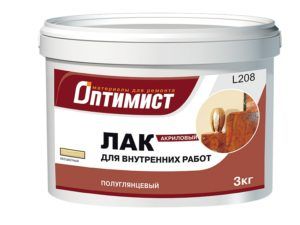 Water-soluble mixtures are both glossy and matte.
Water-soluble mixtures are both glossy and matte.
The main difference between such compositions for varnishing is that water is used as a solvent for chemical components. They are made as follows:
- A dry composition of emulsifiers is poured into the water, acting as a binder.
- The composition is brought to a homogeneous consistency using high-speed mixers.
- In the resulting water-dispersion mixture, special chemical solutions are added, which are responsible for the formation of a protective film, and, if necessary, pigment compositions.
- Everything is thoroughly mixed again until completely homogeneous.
The ingredients added to the aqueous solution can be of two types:
- one-component. Created on the basis of either acrylic or polyurethane;
- two-component. Basically, they immediately contain both acrylic and polyurethane.
The presented additives give the varnishes special properties.
Polyurethane compounds
 The durability of polyurethane mixtures allows them to be used in rooms with high traffic
The durability of polyurethane mixtures allows them to be used in rooms with high traffic
Polyurethane makes varnished surfaces resistant to mechanical damage. It is recommended to treat walls with similar compositions in rooms with the following operating features:
- In the presence of chemical or mechanical stress: for example, frequent wet cleaning with household chemicals and abrasive cleaning agents.
- When a large number of people are in the room.
- With a high probability of physical damage to the walls during operation.
Acrylic compounds
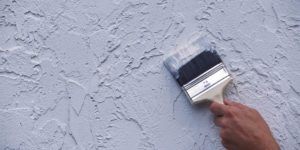 Acrylic varnishes differ from polyurethane types in lower resistance to both mechanical and chemical stress, and to moisture.
Acrylic varnishes differ from polyurethane types in lower resistance to both mechanical and chemical stress, and to moisture.
At the same time, the acrylic compound is more elastic and does not create a vapor-proof film on the walls, which allows the room to "breathe".
Two-component formulations
At its core, this is an improved version of the acrylic compound. Polyurethane additives are added to the standard components based on acrylic to increase its technical properties.

